Comparison of Pluvial Flooding Modeling Software Applied in Highly Urbanized Settlements Using the Case of Lake Ganzirri
Abstract
1. Introduction
2. Materials and Methods
2.1. Study Area
2.2. Software and Hardware
2.3. Simulation Scenarios and Comparisons
- Comparison A: This scheme explored the representation of a highly urbanized settlement in a 2D fashion using as much detail as possible. InfoWorks ICM 2021.9 was used to adopt the building void method to represent buildings, and HEC-RAS 6.2 was used for the proposed method in this paper, as it is not possible to deactivate cells of the mesh in this software. The effects of the different representations of buildings are explored in this comparison scheme.
- Comparison B: This scheme compares a simulated scenario with a proposed pluvial drainage system modeled using InfoWorks ICM 2021.9 and EPA-SWMM 5.2 with a 1D approach. This section explored the differences in using a lumped approach on both software packages. The pluvial drainage system was suggested to drain the runoff of the urbanized area between Via Consolare Pompea and Panoramica del Stretto.
- Comparison C: We explored implementing LID/SUDS elements using incorporated tools in InfoWorks ICM 2021.9 and EPA-SWMM 5.2, which are only available using a 1D approach. A drainage system is required. Therefore, we used the same simulation scenario for comparison B, adding LID/SUDS elements.
- Comparison D: This scheme compares LID/SUDS objects using EPA-SWMM 5.2 and InfoWorks incorporated tools, limited to a 1D approach, and a 2D representation using polygons with adapted meshing, infiltration, and roughness characteristics. This scheme will explore the representation of LID/SUDS control elements directly in the 2D domain, rather than as part of a 1D/2D coupling. The 2D representation was compared to the widely used 1D representation, and the effects on both outcomes were analyzed.
2.4. Comparison Scheme’s Methodology
2.5. Rainfall Input
2.6. Terrain and Land Cover Data
2.7. Data Preparation
2.8. Representation of Topography and 2D Domain
2.9. Representation of Buildings, Roads and Permeable Areas
- Building void (BV): Consider buildings as voids in the mesh. These areas are not taken into account for the analysis and computations;
- Building with solid walls (BSW): Imposed solid wall conditions on the boundaries of each building;
- Building resistance method (BR): A parameter is set at high values to keep the runoff flowing “through” the buildings (e.g., infiltration rate);
- Building block method (BB): Involves adding artificial elevations to the topography of the buildings’ footprints.
2.10. Meshing Details and Adjustments for Representing Flow Around Buildings in HEC-RAS 6.2
2.11. Pluvial Drainage System Design
2.12. Simulation Parameters for 2D Approach and Sub-Catchment Properties for 1D Approach
2.13. LID/SUDS Strategy
3. Results
3.1. Comparison A—Scenario S0 in InfoWorks ICM 2021.9 and HEC-RAS 6.2
3.2. Comparison B—Scenario S1 in InfoWorks ICM 2021.9 and EPA-SWMM 5.2
3.3. Comparison C—Scenario S2 in InfoWorks ICM 2021.9 and EPA-SWMM 5.2
3.4. Comparison D—Scenario S3 in InfoWorks ICM 2021.9 vs. Scenario S3 in EPA-SWMM 5.2, a Comparison Between Approaches
4. Discussion
4.1. InfoWorks ICM 2021.9 vs. HEC-RAS 6.2
4.2. EPA-SWMM 5.2 vs. InfoWorks ICM 2021.9
4.3. LID/SUDS Modeling in 1D
4.4. LID/SUDS Modeling in 2D
4.5. Inclusion of a Protected Water Body in a Highly Urbanized Area Model
4.6. Limitation of Observed Data on the Case Study Area
5. Conclusions
- -
- Efficiency of LID/SUDS control objects on the outflow of the catchment: a 1D approach with surface, pavement, soil, storage, and drainage mat features accordingly is enough using the EPA-SWMM 5.2 and InfoWorks ICM 2021.9 specific tools (LID/SUDS Control Objects).
- -
- Efficiency of LID/SUDS control objects on the propagation of the runoff: A 2D approach (rain-on-grid) is required to define the urban features using a combination of InfoWorks ICM 2021.9 void polygons, mesh zones, roughness zones, infiltration zones (2D), and general lines (as break lines).
- -
- There are no LID/SUDS control tools for 2D analysis. Therefore, LID/SUDS Objects must be spatially represented with polygons with 2D adaptations in roughness and infiltration features to replicate their functionality accordingly.
Author Contributions
Funding
Data Availability Statement
Acknowledgments
Conflicts of Interest
Appendix A
Appendix A.1. Parameters a, b, and c for DDF Curves
| Parameter | 5-Year | 10-Year | 20-Year | 30-Year |
|---|---|---|---|---|
| A | 43.82772 | 53.33399 | 63.65322 | 70.19031 |
| B | 0.21105 | 0.21095 | 0.21083 | 0.21083 |
| C | 0.80897 | 0.80900 | 0.80896 | 0.80896 |
Appendix A.2. Rainfall Intensity
| t (Min) | T5Y-3H 5 Years | T10Y-3H 10 Years | T20Y-3H 20 Years | T30Y-3H 30 Years |
|---|---|---|---|---|
| 0 | 0 | 0 | 0 | 0 |
| 10 | 4.3 | 5.3 | 6.3 | 6.9 |
| 20 | 4.9 | 5.9 | 7.1 | 7.8 |
| 30 | 5.6 | 6.8 | 8.2 | 9 |
| 40 | 6.6 | 8.1 | 9.6 | 10.6 |
| 50 | 8.1 | 9.9 | 11.8 | 13 |
| 60 | 10.5 | 12.8 | 15.3 | 16.8 |
| 70 | 14.9 | 18.2 | 21.7 | 23.9 |
| 80 | 25.3 | 30.7 | 36.6 | 40.4 |
| 90 | 69.8 | 84.9 | 101.3 | 111.7 |
| 100 | 69.8 | 84.9 | 101.3 | 111.7 |
| 110 | 25.3 | 30.7 | 36.6 | 40.4 |
| 120 | 14.9 | 18.2 | 21.7 | 23.9 |
| 130 | 10.5 | 12.8 | 15.3 | 16.8 |
| 140 | 8.1 | 9.9 | 11.8 | 13 |
| 150 | 6.6 | 8.1 | 9.6 | 10.6 |
| 160 | 5.6 | 6.8 | 8.2 | 9 |
| 170 | 4.9 | 5.9 | 7.1 | 7.8 |
| 180 | 4.3 | 5.3 | 6.3 | 6.9 |
| Total * (mm) | 50.0 | 60.9 | 72.6 | 80.0 |
Appendix A.3. Hydrological Features
| Feature | Bacino 1 | Bacino 2 | Bacino 3 | Bacino 4 | Bacino 5 | Bacino 6 | Bacino 7 | Bacino 8 | Bacino 9 | Bacino 10 |
|---|---|---|---|---|---|---|---|---|---|---|
| Total area (ha) * | 10.43 | 10.33 | 10.37 | 9.71 | 5.92 | 9.01 | 9.10 | 16.14 | 7.84 | 10.08 |
| Max elevation (m.a.s.l.) | 70 | 73.2 | 78 | 82 | 80.2 | 81 | 79.8 | 76.5 | 68.5 | 71 |
| Min elevation | 3.5 | 2.4 | 1.3 | 1.2 | 1.1 | 1 | 1 | 0.6 | 0.6 | 0.9 |
| Longest flow path (m) | 682.77 | 634.02 | 799.51 | 587.25 | 552.36 | 559.24 | 812.38 | 921.61 | 428.11 | 467.05 |
| Width (m) * | 152.79 | 162.92 | 129.75 | 165.28 | 107.19 | 161.15 | 112.08 | 175.12 | 183.22 | 215.73 |
| Slope (%) * | 9.74% | 11.17% | 9.59% | 13.76% | 14.32% | 14.31% | 9.70% | 8.24% | 15.86% | 15.01% |
| % Imperv | 62.94% | 69.40% | 61.44% | 72.35% | 63.18% | 70.41% | 64.21% | 72.63% | 76.93% | 54.39% |
| N-Imperv * | 0.011 | 0.011 | 0.011 | 0.011 | 0.011 | 0.011 | 0.011 | 0.011 | 0.011 | 0.011 |
| N-Perv * | 0 | 0 | 0 | 0 | 0 | 0 | 0 | 0 | 0 | 0 |
| Dstore-Imperv (mm) * | 2.5 | 2.5 | 2.5 | 2.5 | 2.5 | 2.5 | 2.5 | 2.5 | 2.5 | 2.5 |
| Dstore-Perv (mm) * | 5 | 5 | 5 | 5 | 5 | 5 | 5 | 5 | 5 | 5 |
| %Zero-Imperv * | 0 | 0 | 0 | 0 | 0 | 0 | 0 | 0 | 0 | 0 |
Appendix A.4. Infiltration Features
| Feature | Bacino 1 | Bacino 2 | Bacino 3 | Bacino 4 | Bacino 5 | Bacino 6 | Bacino 7 | Bacino 8 | Bacino 9 | Bacino 10 |
|---|---|---|---|---|---|---|---|---|---|---|
| P (mm) | 60.9 | 60.9 | 60.9 | 60.9 | 60.9 | 60.9 | 60.9 | 60.9 | 60.9 | 60.9 |
| φ permeable | 0.3 | 0.3 | 0.3 | 0.3 | 0.3 | 0.3 | 0.3 | 0.3 | 0.3 | 0.3 |
| φ impermeable | 0.9 | 0.9 | 0.9 | 0.9 | 0.9 | 0.9 | 0.9 | 0.9 | 0.9 | 0.9 |
| φ | 0.678 | 0.716 | 0.669 | 0.734 | 0.679 | 0.722 | 0.685 | 0.736 | 0.762 | 0.626 |
| Smax (mm) | 28.957 | 24.095 | 30.164 | 22.047 | 28.765 | 23.382 | 27.959 | 21.857 | 19.056 | 36.309 |
| CN | 90 | 91 | 89 | 92 | 90 | 92 | 90 | 92 | 93 | 87 |
| d-store perv (mm) | 5.791 | 4.819 | 6.033 | 4.409 | 5.753 | 4.676 | 5.592 | 4.371 | 3.811 | 7.262 |
Appendix B
Hypothetical Pluvial Drainage System
| Upstream (US) Node | Downstream (DS) Node | US Invert Level | DS Invert Level |
|---|---|---|---|
| J1L | J2L | −1.29 | −1.63 |
| J2L | J3L | −1.63 | −2.01 |
| J3L | J4L | −2.01 | −2.26 |
| J4L | J5L | −2.26 | −2.58 |
| J5L | J6L | −2.58 | −2.79 |
| J6L | J7L | −2.79 | −2.94 |
| J7L | J8L | −2.94 | −3.06 |
| J8L | J9L | −3.06 | −3.22 |
| J9L | OutL | −3.22 | −3.43 |
| J1R | J2R | −2.80 | −2.90 |
| J2R | J3R | −2.90 | −2.94 |
| J3R | J4R | −2.94 | −3.03 |
| J4R | J5R | −3.03 | −3.13 |
| J5R | J6R | −3.13 | −3.26 |
| J6R | J7R | −3.26 | −3.33 |
| J7R | J8R | −3.33 | −3.40 |
| J8R | J9R | −3.40 | −3.42 |
| J9R | J10R | −3.42 | −3.48 |
| J10R | J11R | −3.48 | −3.51 |
| J11R | J12R | −3.51 | −3.53 |
| J12R | J13R | −3.53 | −3.54 |
| J13R | OutR | −3.54 | −3.61 |
| Link | Diameter (m) | Horizontal Length (m) |
|---|---|---|
| C1L | 1.2 | 127.4908 |
| C2L | 1.6 | 137.6964 |
| C3L | 1.6 | 95.0382 |
| C4L | 1.7 | 117.5015 |
| C5L | 2 | 75.0377 |
| C6L | 2 | 57.9111 |
| C7L | 2 | 43.9226 |
| C8L | 2 | 59.4167 |
| C9L | 2 | 76.1756 |
| Link | Diameter (m) | Horizontal Length (m) |
|---|---|---|
| C1R | 2.2 | 140.5288 |
| C2R | 2.2 | 56.772 |
| C3R | 2.2 | 133.0136 |
| C4R | 2.2 | 150.7039 |
| C5R | 2.2 | 192.0743 |
| C6R | 2.2 | 102.0446 |
| C7R | 2.2 | 95.8336 |
| C8R | 2.2 | 34.5288 |
| C9R | 2.2 | 84.6353 |
| C10R | 2.2 | 48.5773 |
| C11R | 2.2 | 30.6906 |
| C12R | 2.2 | 13.4154 |
| C13R | 2.2 | 94.279 |
Appendix C
Appendix C.1. Attributes of Spatial Data
| Urban Feature | Attributes for HEC-RAS 6.2 | Attributes for InfoWorks ICM 2021.9 |
|---|---|---|
| Buildings | Type: Building (all polygons) | Category: Void (all polygons) 1. Void_Id: Void1, Void2,… 2. |
| Permeable areas | Type: Permeable (all polygons) | Infil_Id: Infil1, Infil2,… 2. Rough_Id: Rough1, Rough2,… 2. |
| Roads | Type: Roads (all polygons) | Mesh_Id: Mesh1, Mesh2,… 2. |
| Roads perimeter | N/A | Category: Break line (all lines) 3. |
Appendix C.2. Parameters for HEC-RAS 6.2 and InfoWorks ICM 2021.9 2D Models
| Parameter | Value |
|---|---|
| CELL SIZE (m) | |
| Land Cover Layer | 0.1 |
| Infiltration Layer | 0.1 |
| LAND COVER LAYER | |
| Buildings | |
| ManningsN | 0.016 |
| Percent Impervious (%) 1 | 0 |
| Permeable | |
| ManningsN | 0.06 |
| Percent Impervious (%) | 0 |
| Roads | |
| ManningsN | 0.016 |
| Percent Impervious (%) | 100 |
| INFILTRATION LAYER | |
| Buildings 2 | |
| Initial deficit (mm) | 500 |
| Maximum deficit (mm) | 500 |
| Potential Percolation Rate (mm/hr) | 1.25 |
| Permeable | |
| Initial deficit (mm) | 15 |
| Maximum deficit (mm) | 60 |
| Potential Percolation Rate (mm/hr) | 3 |
| Roads | |
| Initial deficit (mm) | 0 |
| Maximum deficit (mm) | 0 |
| Potential Percolation Rate (mm/hr) | 0 |
| MODIFICATION LAYER | |
| Buildings 3 | |
| Elevation Value | 5 |
| Elevation Type | AddValue |
| Roads 4 | |
| Elevation Value | −0.2 |
| Elevation Type | AddValue |
Appendix C.3. Runoff Surface Properties for Sub-Catchment Assignment in InfoWorks ICM 2021.9
| Runoff Surface ID | 1 | 2 | 3 | 4 |
|---|---|---|---|---|
| Description | Buildings | Roads | Permeable | Residual Area |
| Surface Type | Impervious | Impervious | Pervious | Unknown |
| Routing Model | RAFTS | RAFTS | RAFTS | RAFTS |
| Runoff routing Type | REL | REL | REL | REL |
| Runoff routing value | 0.011 | 0.016 | 0.7 | 0.011 |
| Runoff volume type | Fixed | Fixed | DefConLoss | Fixed |
| Fixed runoff coefficient | 0.9 | 0.9 | n/a | 0.9 |
| Maximum deficit (mm) | n/a | n/a | 5 | n/a |
| Infiltration loss coefficient | n/a | n/a | 2.5 | n/a |
| Initial loss porosity | 1 (default) | 1 (default) | 1 (default) | 1 (default) |
| Initial loss type | Abs | Abs | Abs | Abs |
| Initial loss value (m) | 0 (default) | 0 (default) | 0 (default) | 0 (default) |
Appendix C.4. Runoff Surface Properties for Sub-Catchment Assignment in InfoWorks ICM 2021.9
| Parameter | Value |
|---|---|
| SURFACE | |
| Berm height (mm) | 500 |
| Vegetation Volume Fraction | 0.1 |
| Surface Roughness (Manning’s n) | 0.05 |
| Surface Slope (%) | 2 |
| SOIL | |
| Thickness (mm) | 30 |
| Porosity (volume fraction) | 0.5 |
| Field Capacity (volume fraction) | 0.3 |
| Wilting point (volume fraction) | 0.05 |
| Conductivity (mm/hr) | 25 |
| Conductivity Slope | 15 |
| Suction Head (mm) | 110 |
| DRAINAGE MAT | |
| Thickness (mm) | 10 |
| Void Fraction | 0.5 |
| Roughness (Mannings n) | 0.1 |
| Parameter | Value |
|---|---|
| SURFACE | |
| Berm height (mm) | 2 |
| Vegetation Volume Fraction | 0.0 |
| Surface Roughness (Mannings n) | 0.1 |
| Surface Slope (%) | 1.5 |
| PAVEMENT | |
| Thickness (mm) | 120 |
| Void Ratio (Voids/Solids) | 0.275 |
| Impervious Surface Fraction | 0 |
| Permeability (mm/hr) | 3736 |
| Clogging Factor | 0 |
| Regeneration Interval (days) | 0 |
| Regeneration Fraction | 0 |
| STORAGE | |
| Thickness (mm) | 340 |
| Void Ratio (Voids/Solids) | 0.305 |
| Seepage Rate (mm/hr) | 100 |
| Clogging Factor | 0 |
| Parameter | Value |
|---|---|
| SURFACE | |
| Berm height (mm) | 350 |
| Vegetation Volume Fraction | 0.2 |
| Surface Roughness (Mannings n) | 0.13 |
| Surface Slope (%) | 0.1 |
| SOIL | |
| Thickness (mm) | 740 |
| Porosity (volume fraction) | 0.46 |
| Field Capacity (volume fraction) | 0.4 |
| Wilting point (volume fraction) | 0.33 |
| Conductivity (mm/hr) | 230 |
| Conductivity Slope | 10 |
| Suction Head (mm) | 17 |
| STORAGE | |
| Thickness (mm) | 10 |
| Void Ratio (Voids/Solids) | 0.75 |
| Seepage Rate (mm/hr) | 0 |
| Clogging Factor | 0 |
Appendix C.5. Distribution of Areas per Sub-Catchment for Comparison Scheme C
| Sub-Catchment | Total Area (ha) | Buildings (Roof Area) (ha) | Green Roofs (ha) | Roads (ha) | Permeable Pavement (ha) | Pervious Area (ha) | Bio-retention Cell (ha) | Residual Areas (ha) |
|---|---|---|---|---|---|---|---|---|
| Basin 1 | 10.43 | - | 2.07 | 0.30 | 0.92 | 2.71 | 1.16 | 3.28 |
| Basin 2 | 10.33 | - | 1.78 | 0.64 | 1.22 | 2.21 | 0.95 | 3.53 |
| Basin 3 | 10.37 | - | 1.58 | 0.22 | 0.79 | 2.80 | 1.20 | 3.78 |
| Basin 4 | 9.71 | - | 1.25 | 0.46 | 0.93 | 1.88 | 0.81 | 4.38 |
| Basin 5 | 5.92 | - | 0.71 | 0.39 | 0.44 | 1.53 | 0.65 | 2.20 |
| Basin 6 | 9.01 | - | 1.05 | 0.28 | 0.51 | 1.87 | 0.80 | 4.52 |
| Basin 7 | 9.10 | - | 0.78 | 0.45 | 0.92 | 2.28 | 0.98 | 3.69 |
| Basin 8 | 16.14 | - | 1.45 | 0.82 | 1.41 | 3.09 | 1.33 | 8.04 |
| Basin 9 | 7.84 | - | 0.71 | 0.45 | 0.52 | 1.27 | 0.54 | 4.36 |
| Basin 10 | 10.08 | - | 0.93 | 0.41 | 0.31 | 3.22 | 1.38 | 3.82 |
References
- Gu, D.; Andreev, K.; Dupre, M.E. Major Trends in Population Growth Around the World. China CDC Wkly. 2021, 3, 604–613. [Google Scholar] [CrossRef]
- Jha, A.K.; Bloch, R.; Lamond, J. Cities and Flooding: A Guide to Integrated Urban Flood Risk Management for the 21st Century; The World Bank: Washington, DC, USA, 2012. [Google Scholar] [CrossRef]
- Associated Programme on Flood Management. Urban Flood Risk Management—A Tool for Integrated Flood Management; WMO: Geneva, Switzerland, 2008. [Google Scholar]
- Azadgar, A.; Gańcza, A.; Asl, S.R.; Salata, S.; Nyka, L. Optimizing Nature-Based Solutions for Urban Flood Risk Mitigation: A Multi-Objective Genetic Algorithm Approach in Gdańsk, Poland. Sci. Total Environ. 2025, 963, 178303. [Google Scholar] [CrossRef] [PubMed]
- Berghauser Pont, M.; Haupt, P.; Berg, P.; Alstäde, V.; Heyman, A. Systematic Review and Comparison of Densification Effects and Planning Motivations. Build. Cities 2021, 2, 378. [Google Scholar] [CrossRef]
- Kim, H.W.; Mingh-Han, L.; Jun-Hyun, K.; Fouad, J. Examining the Impact of Suburbanization on Surface Runoff Using the SWAT. Int. J. Environ. Res. 2016, 10, 379–390. [Google Scholar]
- Salvadore, E.; Bronders, J.; Batelaan, O. Hydrological Modelling of Urbanized Catchments: A Review and Future Directions. J. Hydrol. 2015, 529, 62–81. [Google Scholar] [CrossRef]
- Bagheri, A.; Liu, G.-J. Climate Change and Urban Flooding: Assessing Remote Sensing Data and Flood Modeling Techniques: A Comprehensive Review. Environ. Rev. 2025, 33, 1–14. [Google Scholar] [CrossRef]
- Amrei, D.; Britta, S. A Systematic Analysis of the Interaction between Rain-on-Grid-Simulations and Spatial Resolution in 2D Hydrodynamic Modeling. Water 2021, 13, 2346. [Google Scholar] [CrossRef]
- Hall, J. Direct Rainfall Flood Modelling: The Good, the Bad and the Ugly. AJWR 2015, 19, 74–85. [Google Scholar] [CrossRef]
- David, A.; Schmalz, B. Flood Hazard Analysis in Small Catchments: Comparison of Hydrological and Hydrodynamic Approaches by the Use of Direct Rainfall. J. Flood Risk Manag. 2020, 13, e12639. [Google Scholar] [CrossRef]
- Pati, A.; Sahoo, B.; Kale, R.V. A Coupled Modeling Approach for Urban Flood Inundation Mapping under Data-Limited Conditions. J. Hydrol. 2025, 661, 133573. [Google Scholar] [CrossRef]
- Da Silva Diniz, G.J.; Scudelari, A.C.; De Medeiros, J.D.F. Performance of Low Impact Development Techniques in Flood Hazard Mitigation in a Closed Urbanised Catchment for Extreme Precipitation Events. Urban Water J. 2024, 21, 987–1002. [Google Scholar] [CrossRef]
- Ni, T.; Zhang, X.; Leng, P.; Pelling, M.; Xu, J. Comprehensive Benefits Evaluation of Low Impact Development Using Scenario Analysis and Fuzzy Decision Approach. Sci. Rep. 2025, 15, 2227. [Google Scholar] [CrossRef]
- Martínez, C.; Vojinovic, Z.; Sanchez, A. Multi-Objective Model-Based Assessment of Green-Grey Infrastructures for Urban Flood Mitigation. Hydrology 2021, 8, 110. [Google Scholar] [CrossRef]
- Ortega Sandoval, A.D.; Sörensen, J.; Rodríguez, J.P.; Bharati, L. Hydrologic–Hydraulic Assessment of SUDS Control Capacity Using Different Modeling Approaches: A Case Study in Bogotá, Colombia. Water Sci. Technol. 2023, 87, 3124–3145. [Google Scholar] [CrossRef]
- Neumann, J.; Scheid, C.; Dittmer, U. Potential of Decentral Nature-Based Solutions for Mitigation of Pluvial Floods in Urban Areas—A Simulation Study Based on 1D/2D Coupled Modeling. Water 2024, 16, 811. [Google Scholar] [CrossRef]
- Kant, C.; Meena, R.S.; Singh, S.K. A Critical Appraisal on Various Hydrological and Hydrodynamic Models. Water Conserv. Sci. Eng. 2025, 10, 24. [Google Scholar] [CrossRef]
- Krvavica, N.; Rubinić, J. Evaluation of Design Storms and Critical Rainfall Durations for Flood Prediction in Partially Urbanized Catchments. Water 2020, 12, 2044. [Google Scholar] [CrossRef]
- Rangari, V.A.; Umamahesh, N.V.; Bhatt, C.M. Assessment of Inundation Risk in Urban Floods Using HEC RAS 2D. Model. Earth Syst. Environ. 2019, 5, 1839–1851. [Google Scholar] [CrossRef]
- Somma, R.; Spoto, S.E.; Giacobbe, S. Geological and Structural Framework, Inventory, and Quantitative Assessment of Geodiversity: The Case Study of the Lake Faro and Lake Ganzirri Global Geosites (Italy). Geosciences 2024, 14, 236. [Google Scholar] [CrossRef]
- Chiofalo, N. Efficacia di Interventi di Drenaggio Urbano Sostenibile Nella Mitigaziones del Rischio di Allagamenti Urbani: Il caso del Lago di Ganzirri. Master’s Thesis, Università degli studi di Messina, Messina, Italy, 2019. [Google Scholar]
- European Environmental Agency. Directive 2000/60/EC of the European Parliament and of the Council of 23 October 2000 Establishing a Framework for Community Action in the Field of Water Policy. Off. J. Eur. Communities 2000, 1–73. Available online: https://eur-lex.europa.eu/eli/dir/2000/60/oj/eng (accessed on 5 June 2024).
- Costabile, P.; Costanzo, C.; Ferraro, D.; Macchione, F.; Petaccia, G. Performances of the New HEC-RAS Version 5 for 2-D Hydrodynamic-Based Rainfall-Runoff Simulations at Basin Scale: Comparison with a State-of-the Art Model. Water 2020, 12, 2326. [Google Scholar] [CrossRef]
- Brunner, G. HEC-RAS 2D User’s Manual. 2024. Available online: https://www.hec.usace.army.mil/software/hec-ras/documentation/HEC-RAS_2D_Users_Manual_v6.5.pdf (accessed on 5 June 2024).
- Rossman, L.A. Storm Water Management Model Reference Manual Volume II–Hydraulics; National Risk Management Laboratory: Cincinnati, OH, USA, 2017; Volume II. [Google Scholar]
- Cozzolino, L.; Varra, G.; Cimorelli, L.; Pianese, D.; Della Morte, R. Friction Decoupling and Loss of Rotational Invariance in 2D Flooding Models. Adv. Water Resour. 2021, 152, 103919. [Google Scholar] [CrossRef]
- Yang, J.; Xiang, Y.; Xu, X.; Sun, J. Design Hyetograph for Short-Duration Rainstorm in Jiangsu. Atmosphere 2022, 13, 899. [Google Scholar] [CrossRef]
- Bonaccorso, B.; Brigandì, G.; Aronica, G.T. Regional Sub-Hourly Extreme Rainfall Estimates in Sicily Under a Scale Invariance Framework. Water Resour. Manag. 2020, 34, 4363–4380. [Google Scholar] [CrossRef]
- Regione Siciliana. Annali Idrologici. Available online: https://www.regione.sicilia.it/istituzioni/regione/strutture-regionali/presidenza-regione/autorita-bacino-distretto-idrografico-sicilia/annali-idrologici (accessed on 30 July 2025).
- Chen, W.; Zheng, M.; Gao, Q.; Deng, C.; Ma, Y.; Ji, G. Simulation of Surface Runoff Control Effect by Permeable Pavement. Water Sci. Technol. 2021, 83, 948–960. [Google Scholar] [CrossRef]
- Ming, X.; Liang, Q.; Xia, X.; Li, D.; Fowler, H.J. Real-Time Flood Forecasting Based on a High-Performance 2-D Hydrodynamic Model and Numerical Weather Predictions. Water Resour. Res. 2020, 56, e2019WR025583. [Google Scholar] [CrossRef]
- Zhu, Y.; Burlando, P.; Tan, P.Y.; Blagojevic, J.; Fatichi, S. Investigating the Influence of Urban Morphology on Pluvial Flooding: Insights from Urban Catchments in England (UK). Sci. Total Environ. 2024, 953, 176139. [Google Scholar] [CrossRef] [PubMed]
- Costabile, P.; Costanzo, C.; Ferraro, D.; Barca, P. Is HEC-RAS 2D Accurate Enough for Storm-Event Hazard Assessment? Lessons Learnt from a Benchmarking Study Based on Rain-on-Grid Modelling. J. Hydrol. 2021, 603, 126962. [Google Scholar] [CrossRef]
- Schubert, J.E.; Sanders, B.F.; Smith, M.J.; Wright, N.G. Unstructured Mesh Generation and Landcover-Based Resistance for Hydrodynamic Modeling of Urban Flooding. Adv. Water Resour. 2008, 31, 1603–1621. [Google Scholar] [CrossRef]
- Mustafa, A.; Szydłowski, M. Application of Different Building Representation Techniques in HEC-RAS 2-D for Urban Flood Modeling Using the Toce River Experimental Case. PeerJ 2021, 9, e11667. [Google Scholar] [CrossRef]
- Rossman, L.A.; Huber, W.C. Storm Water Management Model Reference Manual Volume I–Hydrology (Revised); National Risk Management Laboratory: Cincinnati, OH, USA, 2016; Volume I. [Google Scholar]
- Paoletti, A. Sistemi di Fognatura e di Drenaggio Urbano: Fondamenti e Nuove Tendenze, 2nd ed.; CUSL: Milano, Italy, 2002. [Google Scholar]
- Artina, S. (Ed.) Sistemi di Fognatura: Manuale di Progettazione; Centro Studi Deflussi Urbani: Milano, Italy, 1997. [Google Scholar]
- Hellmers, S.; Manojlović, N.; Palmaricciotti, G.; Kurzbach, S.; Fröhle, P. Multiple Linked Sustainable Drainage Systems in Hydrological Modelling for Urban Drainage and Flood Risk Management. J. Flood Risk Manag. 2018, 11, S5–S16. [Google Scholar] [CrossRef]
- Hamouz, V.; Muthanna, T.M. Hydrological Modelling of Green and Grey Roofs in Cold Climate with the SWMM Model. J. Environ. Manag. 2019, 249, 109350. [Google Scholar] [CrossRef] [PubMed]
- Gülbaz, S.; Kazezyılmaz-Alhan, C.M. An Evaluation of Hydrologic Modeling Performance of EPA SWMM for Bioretention. Water Sci. Technol. 2017, 76, 3035–3043. [Google Scholar] [CrossRef]
- Milanesi, L.; Pilotti, M.; Ranzi, R. A Conceptual Model of People’s Vulnerability to Floods. Water Resour. Res. 2015, 51, 182–197. [Google Scholar] [CrossRef]
- Development of the 2D Computational Mesh. Available online: https://www.hec.usace.army.mil/confluence/rasdocs/r2dum/6.2/development-of-a-2d-or-combined-1d-2d-model/development-of-the-2d-computational-mesh (accessed on 26 June 2025).
- Help|Two Dimensional Flood Routing Basics|Autodesk. Available online: https://help.autodesk.com/view/IWICMS/2025/ENU/?guid=GUID-F4490F8E-108D-4C14-B31A-D01C793668E1 (accessed on 26 June 2025).
- Shewchuk, J.R. Triangle: Engineering a 2D Quality Mesh Generator and Delaunay Triangulator. In Applied Computational Geometry Towards Geometric Engineering; Lin, M.C., Manocha, D., Eds.; Lecture Notes in Computer Science; Springer: Berlin/Heidelberg, Germany, 1996; Volume 1148, pp. 203–222. [Google Scholar] [CrossRef]
- Ye, C.; Xu, Z.; Lei, X.; Liao, W.; Ding, X.; Liang, Y. Assessment of Urban Flood Risk Based on Data-Driven Models: A Case Study in Fuzhou City, China. Int. J. Disaster Risk Reduct. 2022, 82, 103318. [Google Scholar] [CrossRef]
- Costabile, P.; Costanzo, C.; Kalogiros, J.; Bellos, V. Toward Street-Level Nowcasting of Flash Floods Impacts Based on HPC Hydrodynamic Modeling at the Watershed Scale and High-Resolution Weather Radar Data. Water Resour. Res. 2023, 59, e2023WR034599. [Google Scholar] [CrossRef]
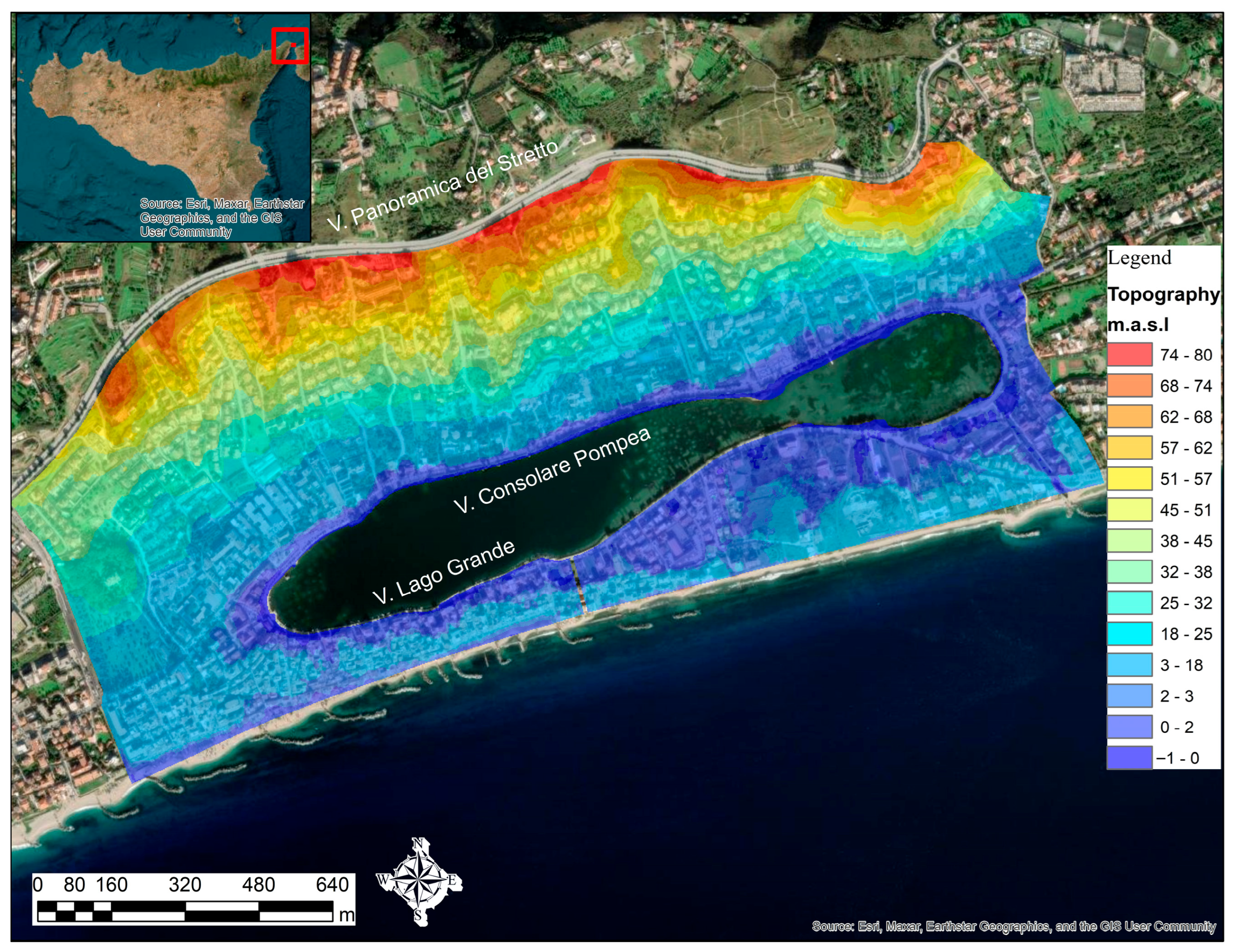
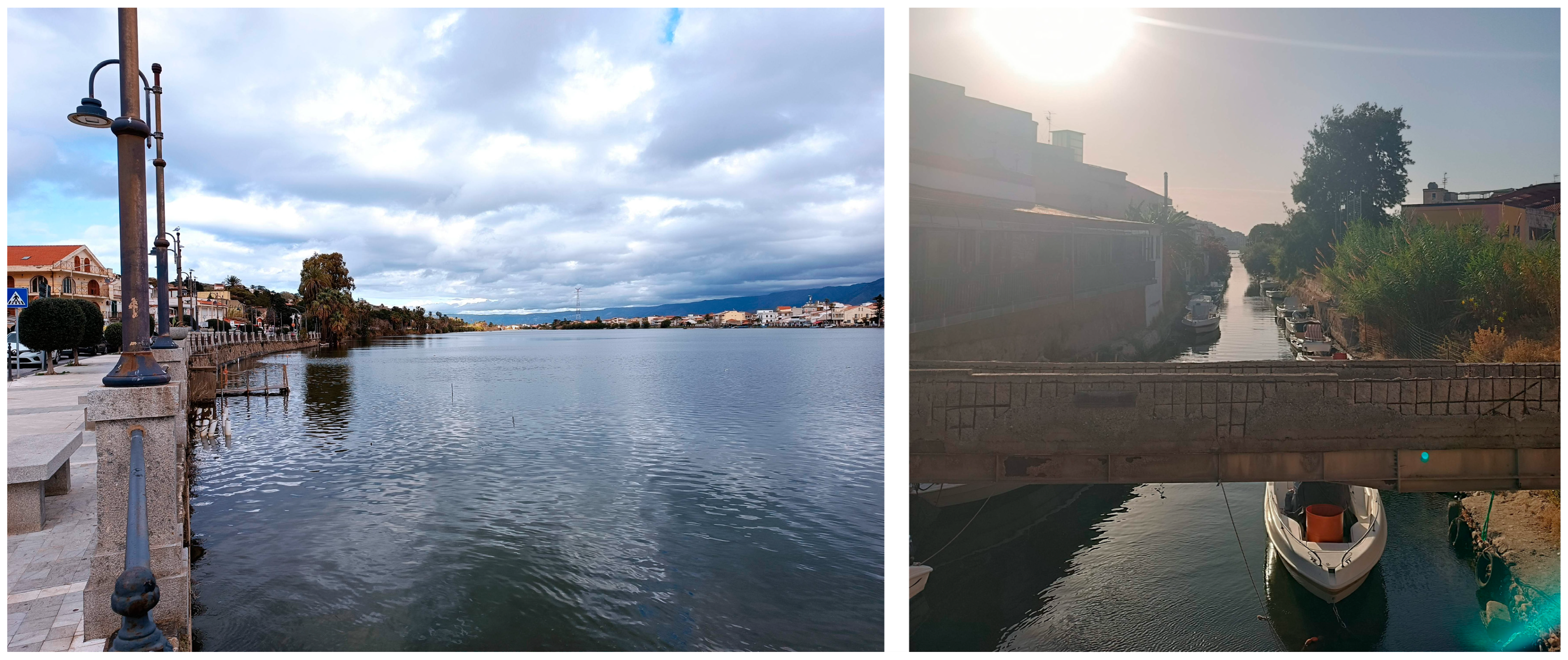
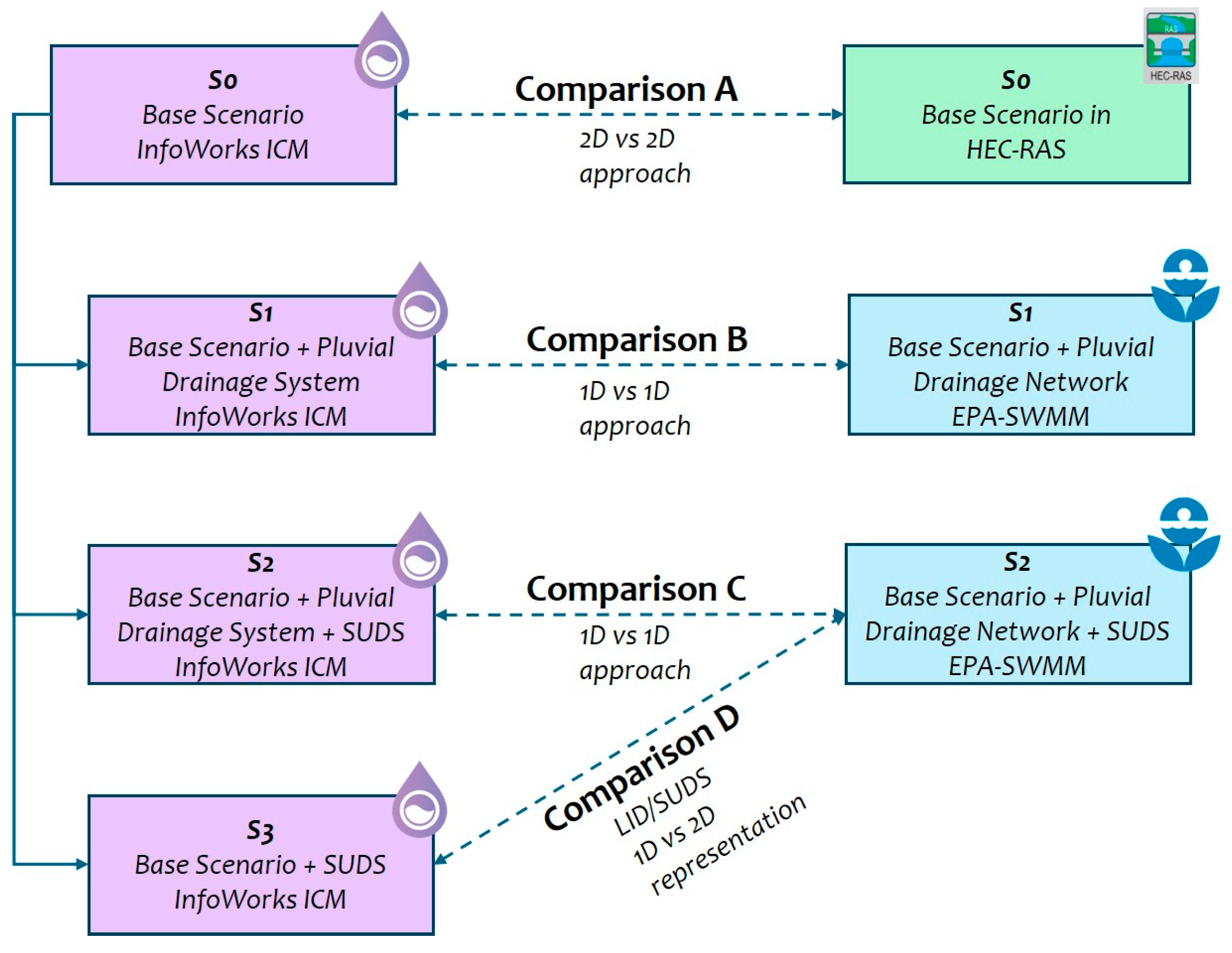
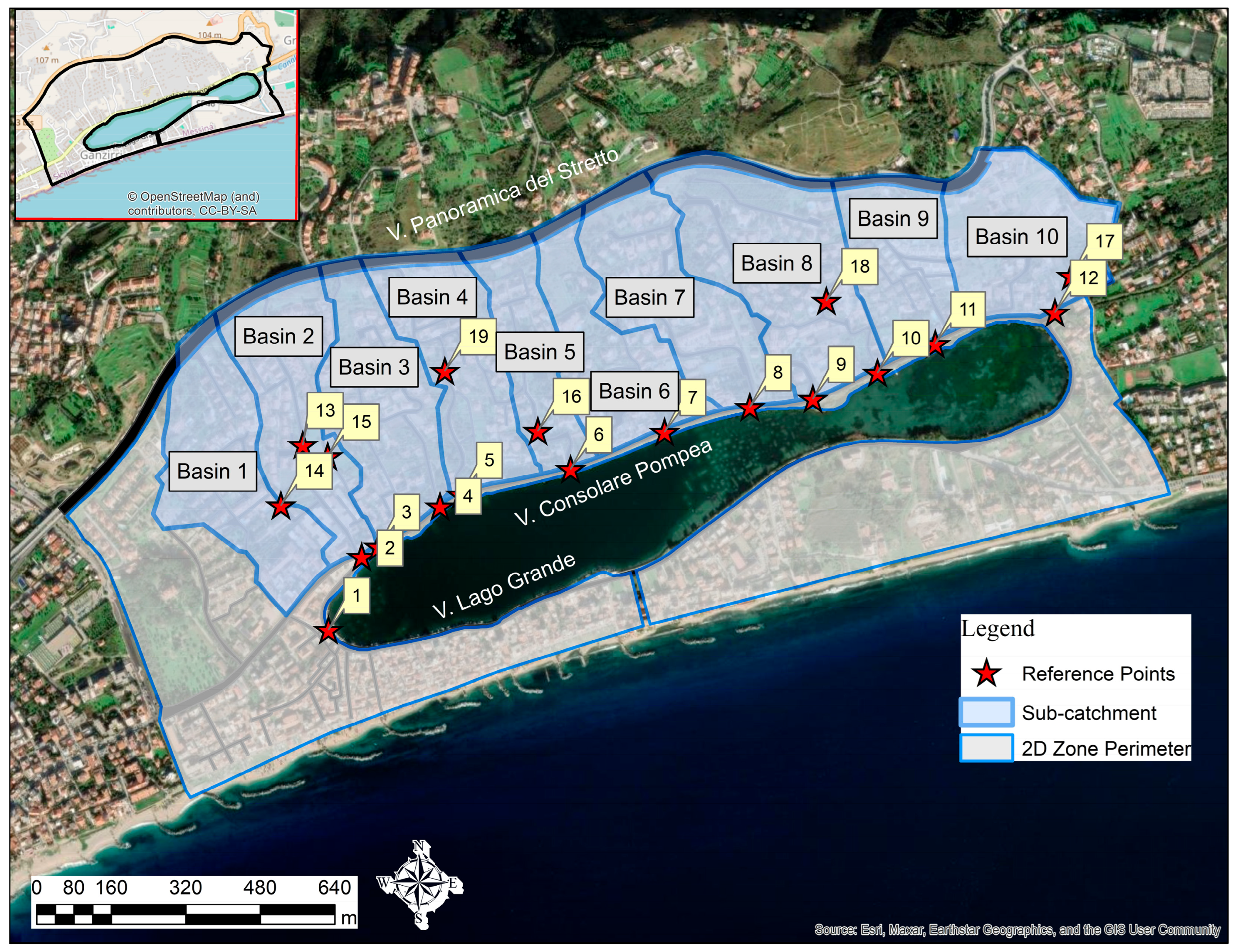
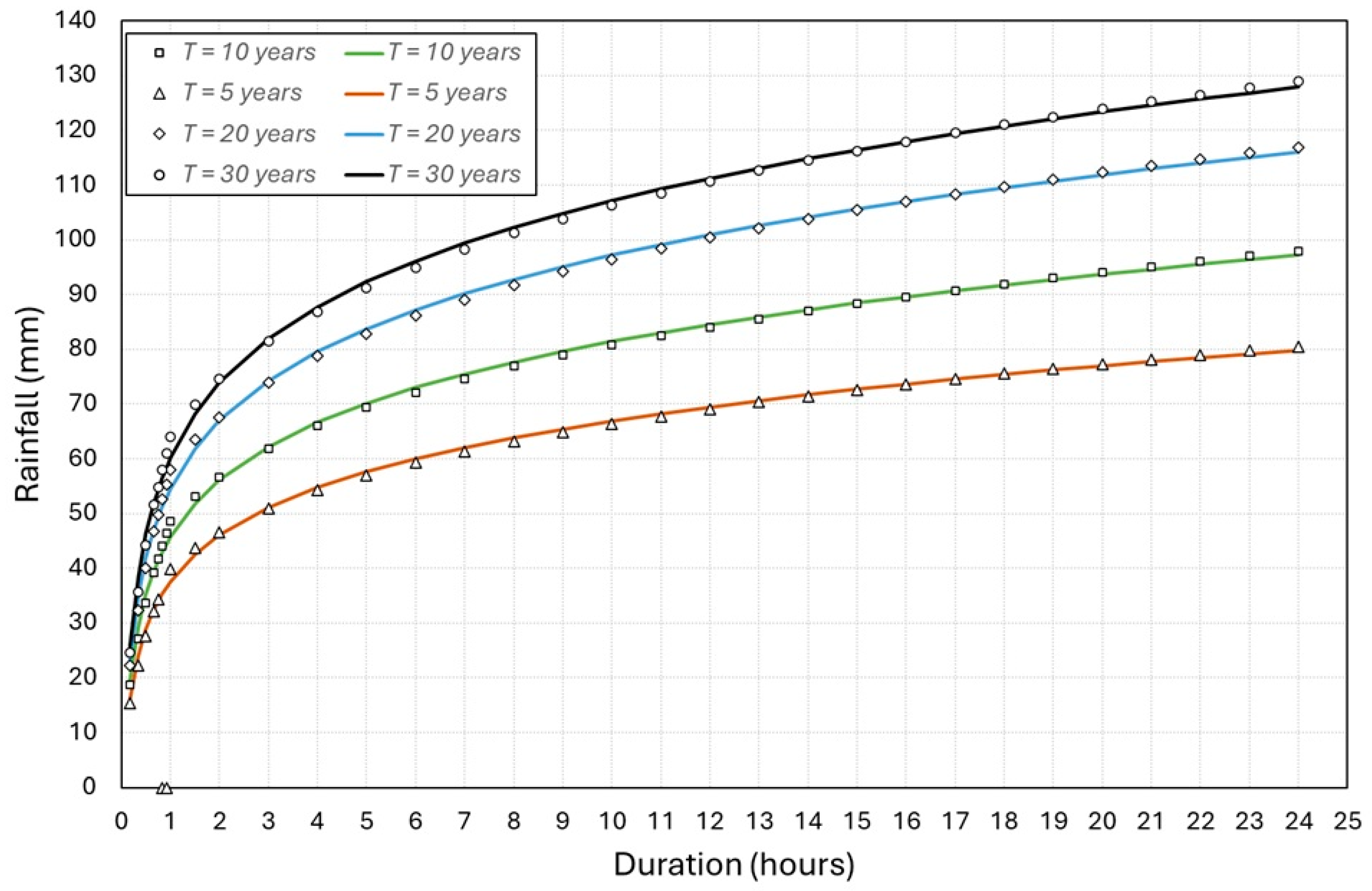
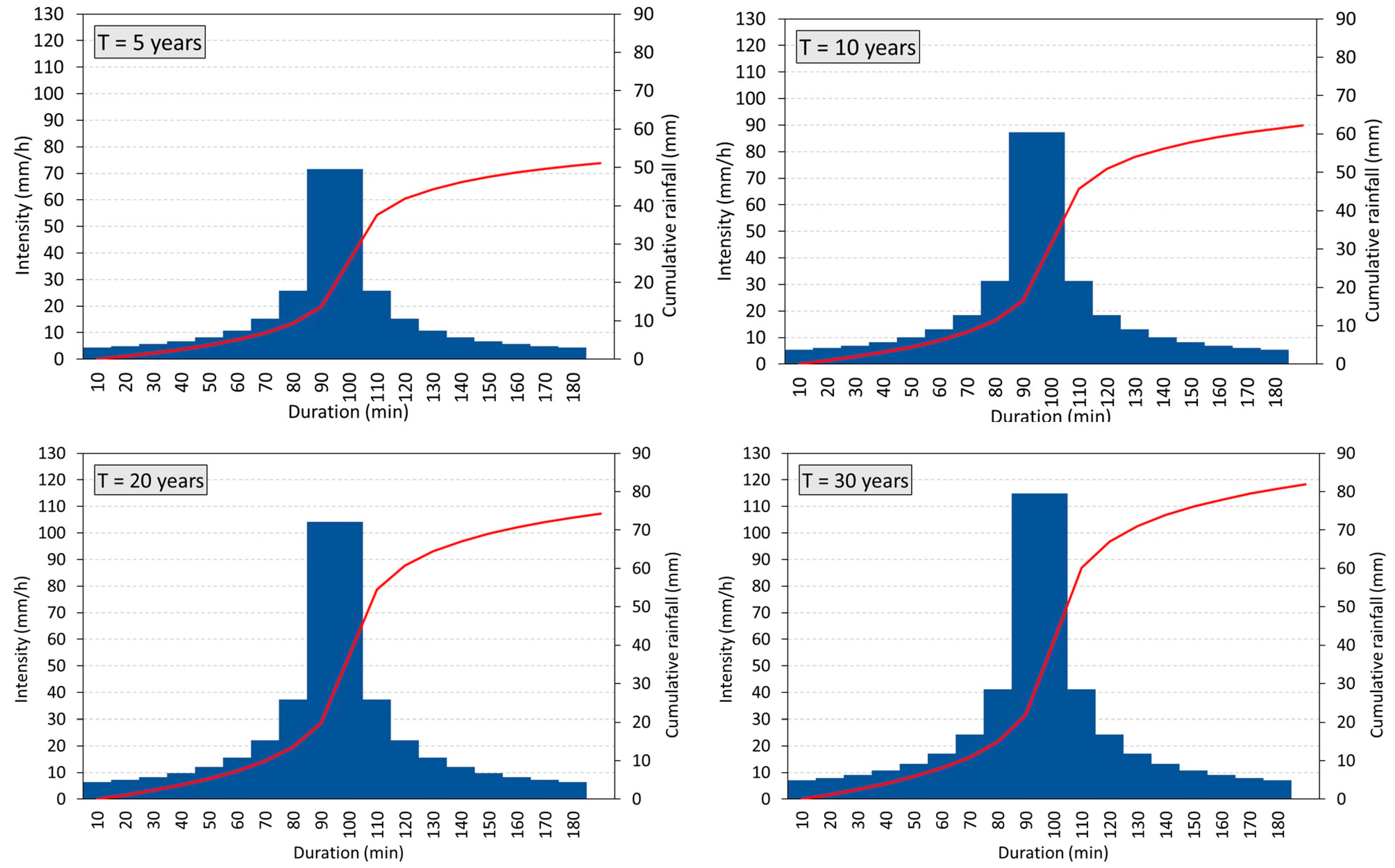
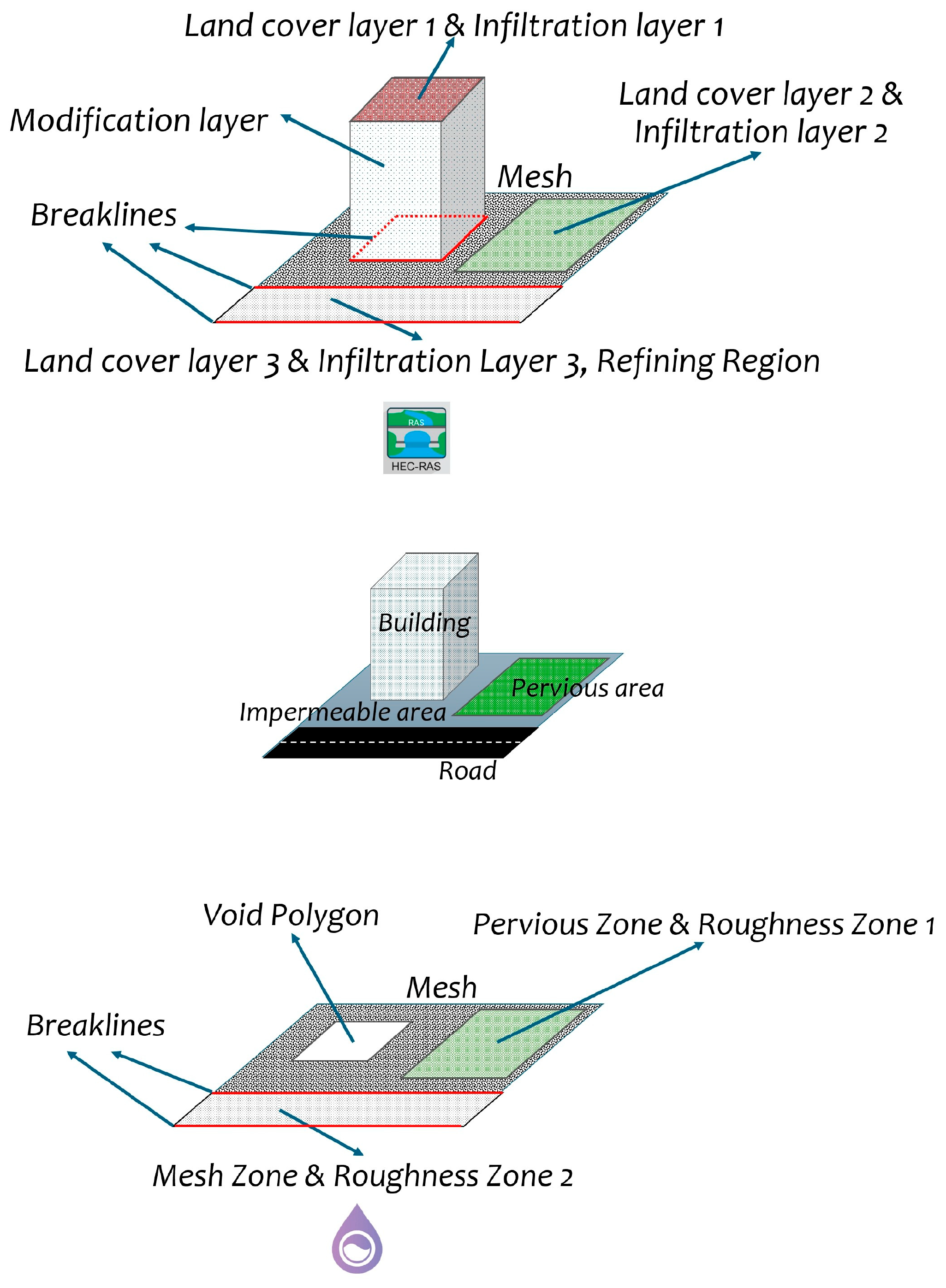
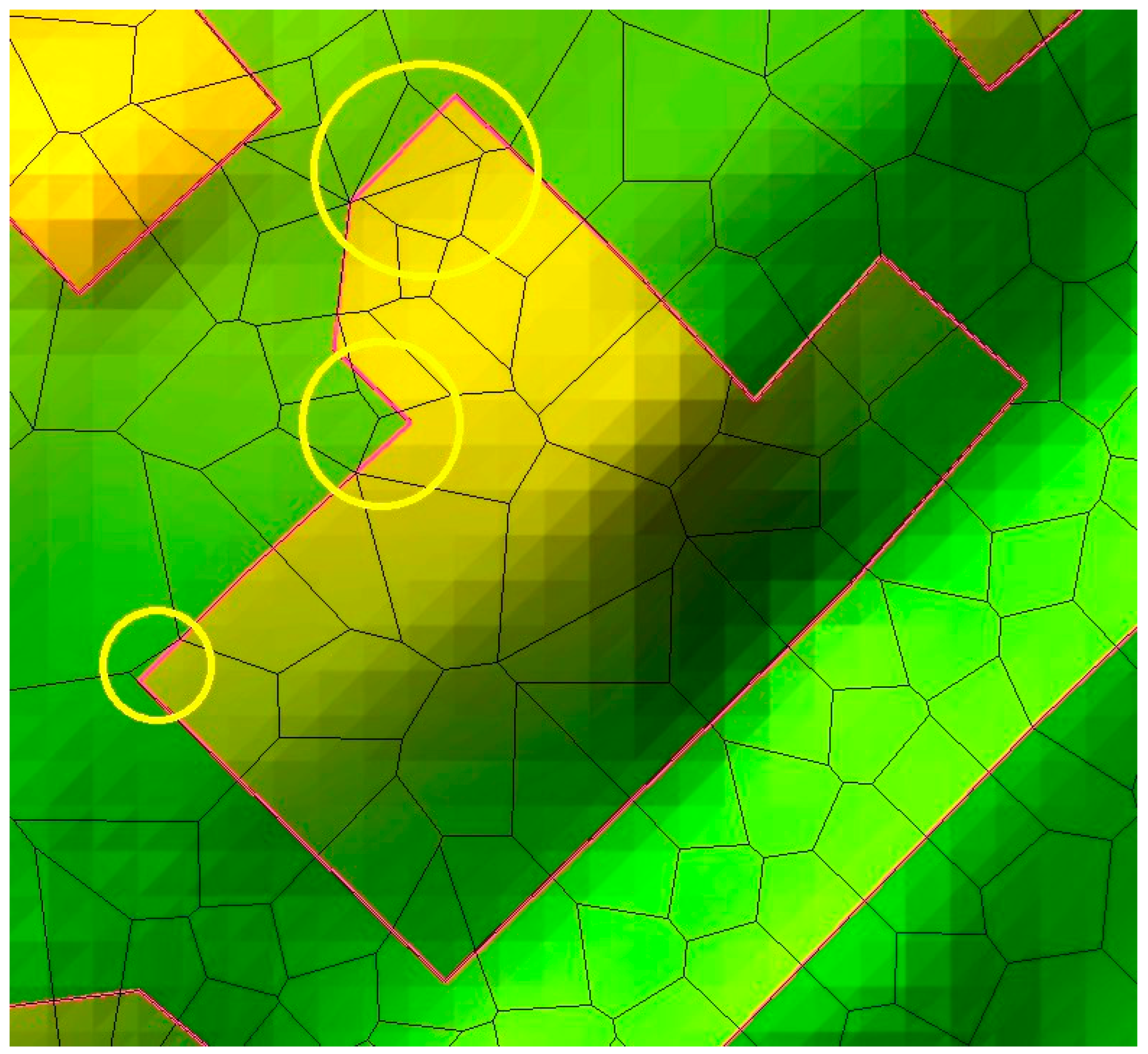
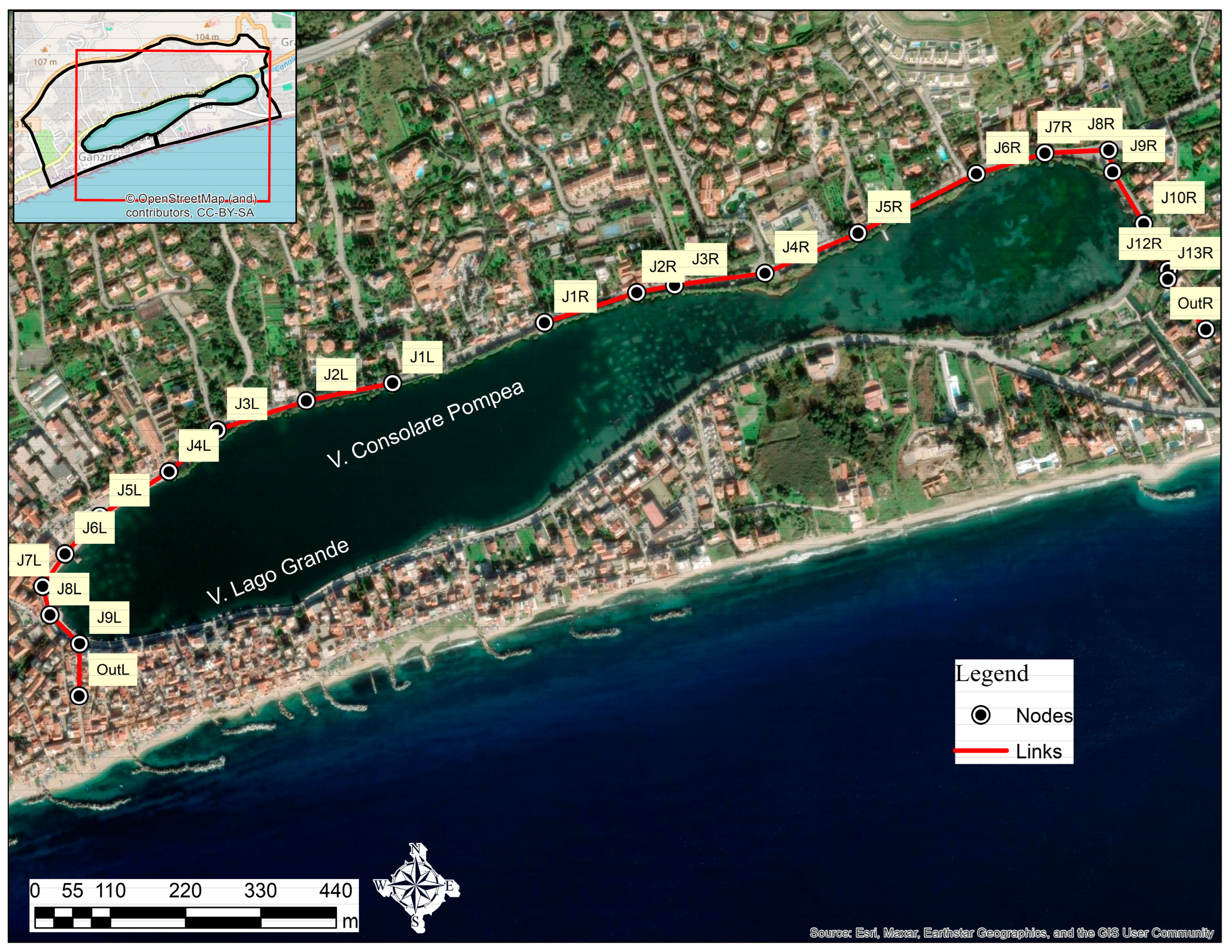
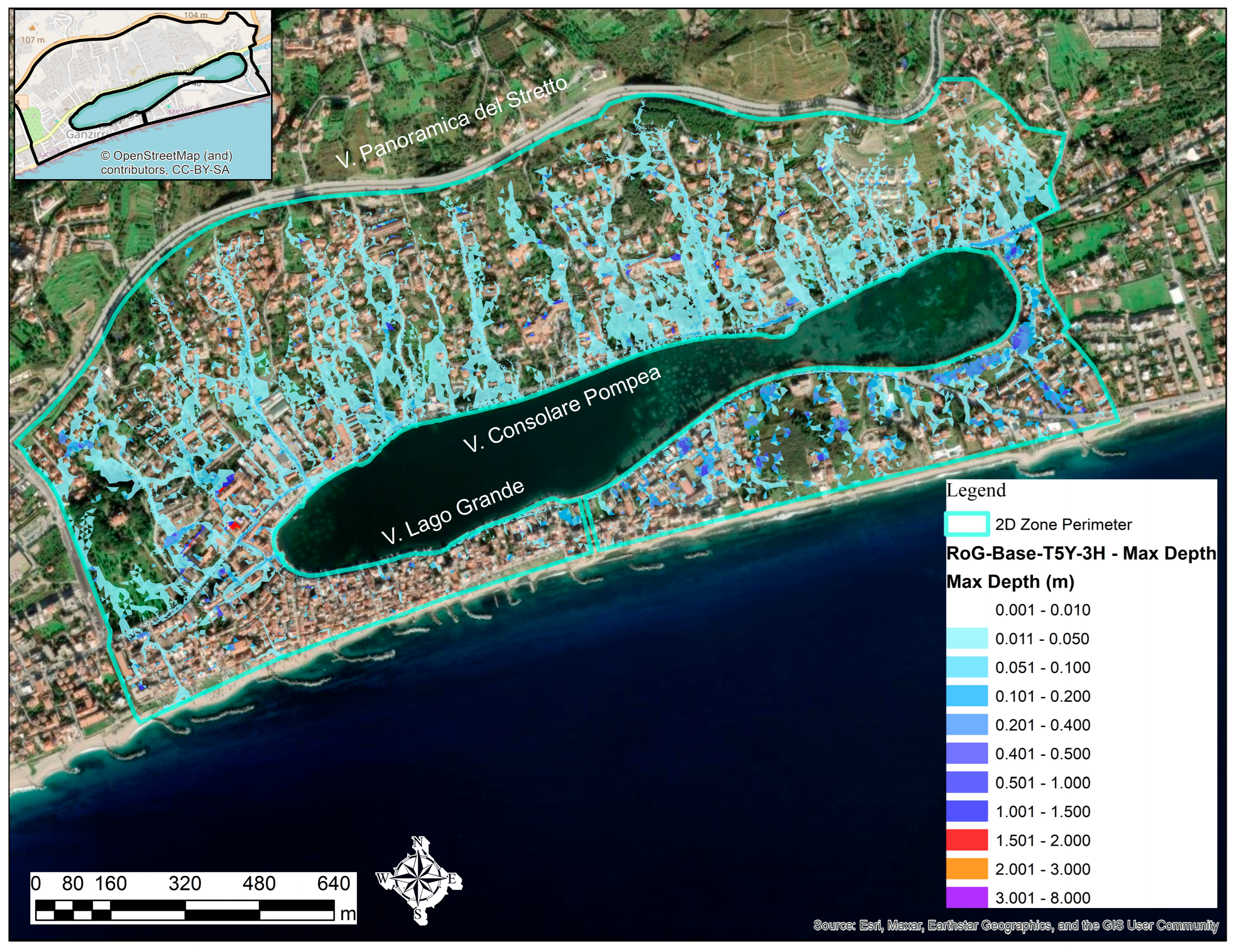
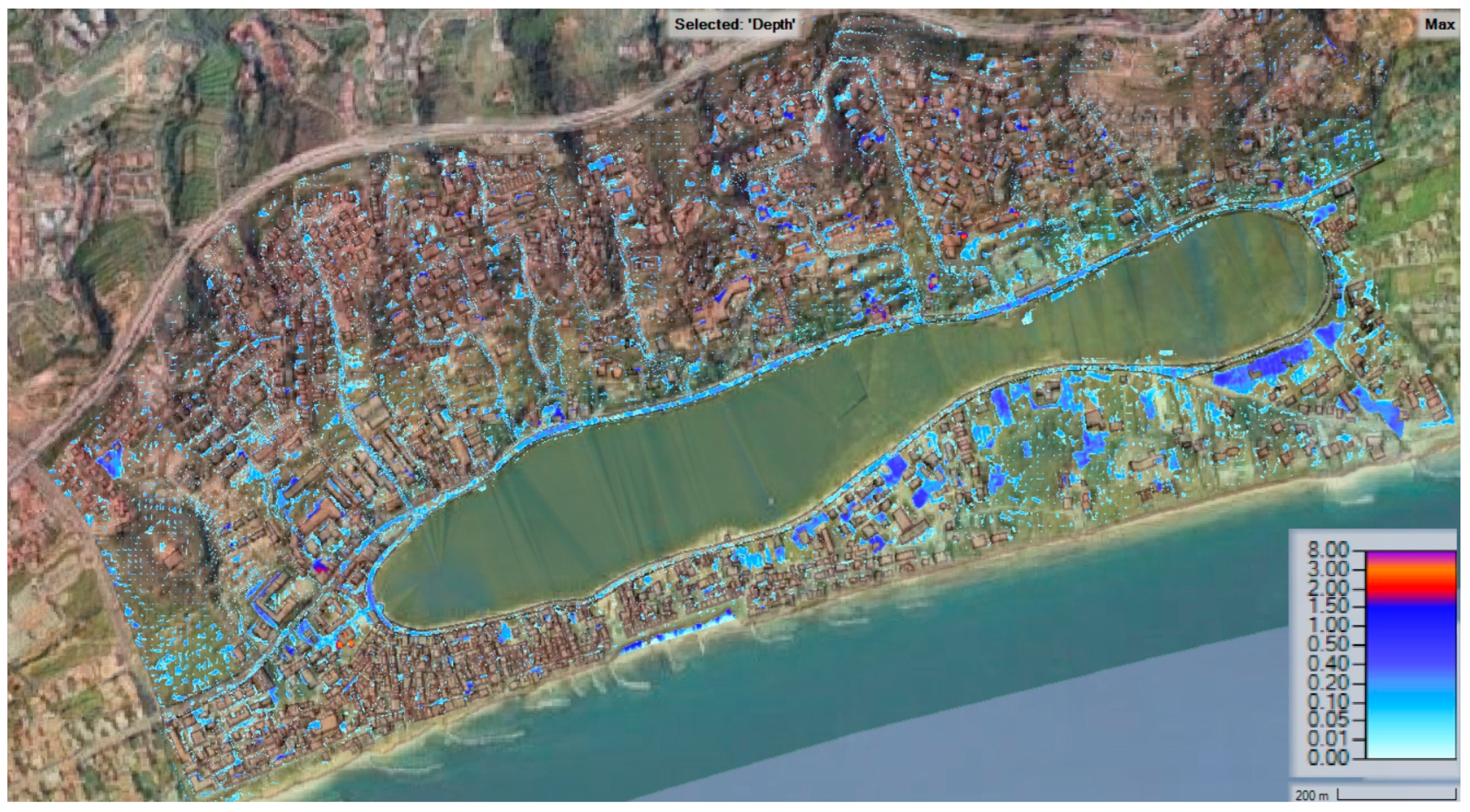
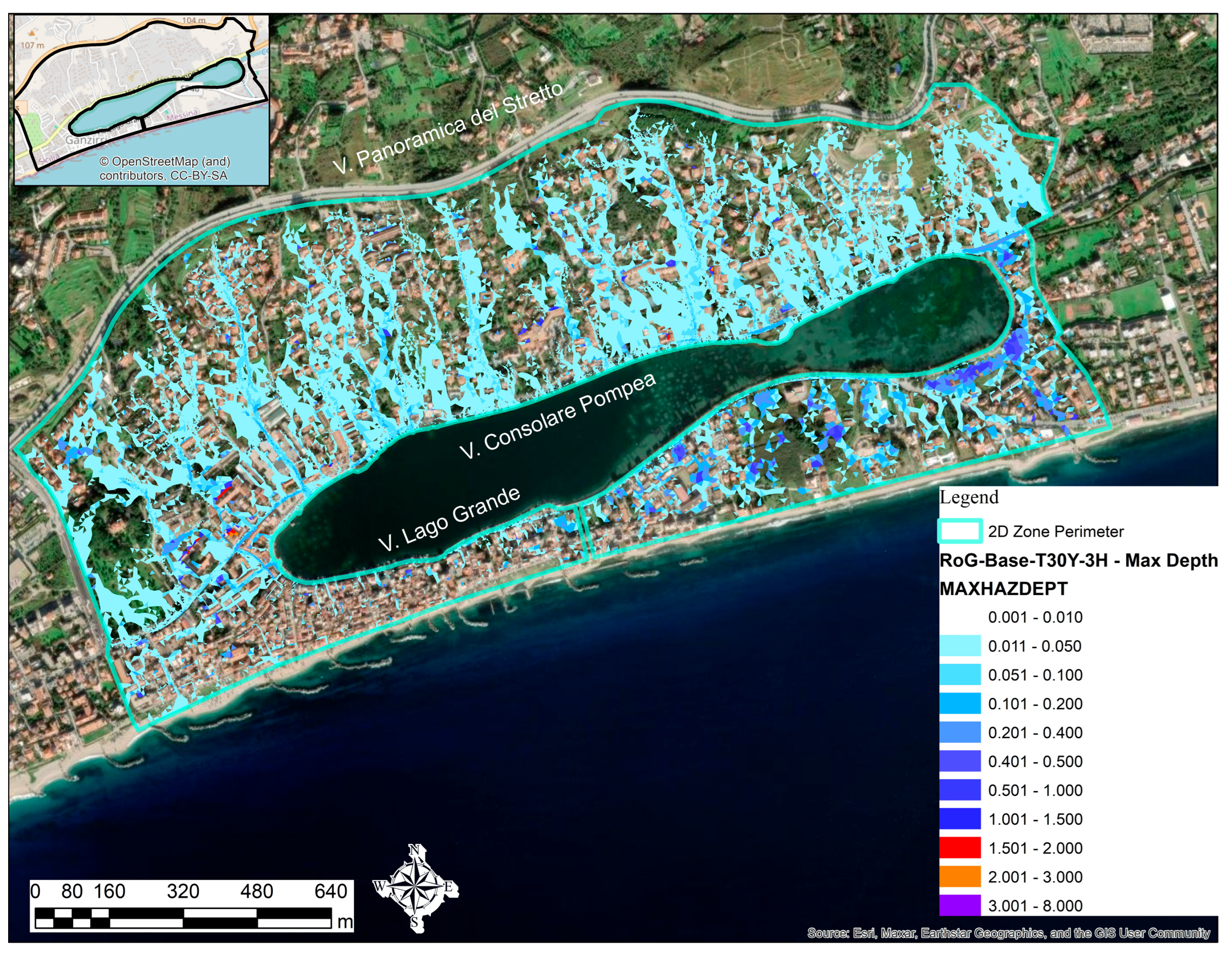
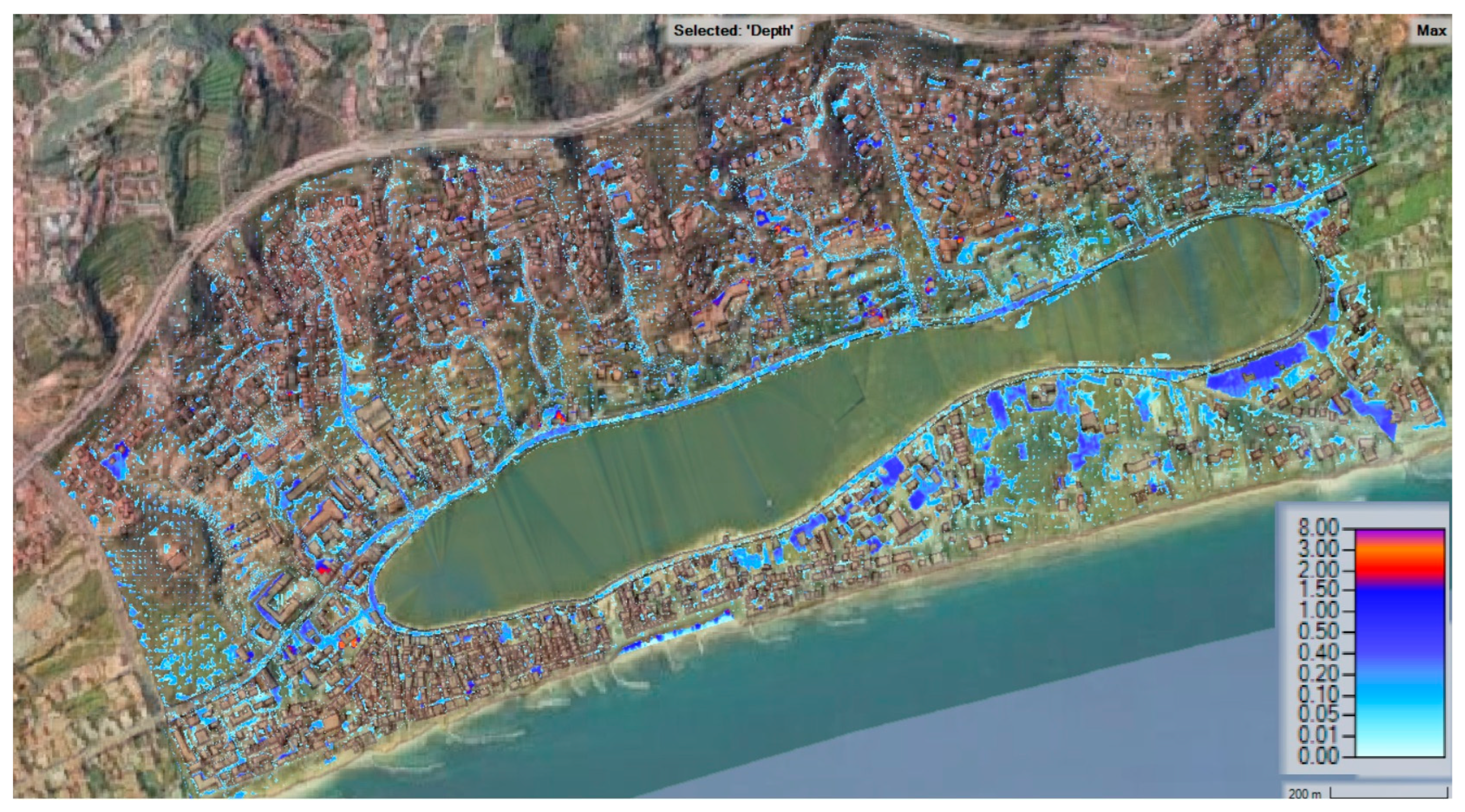
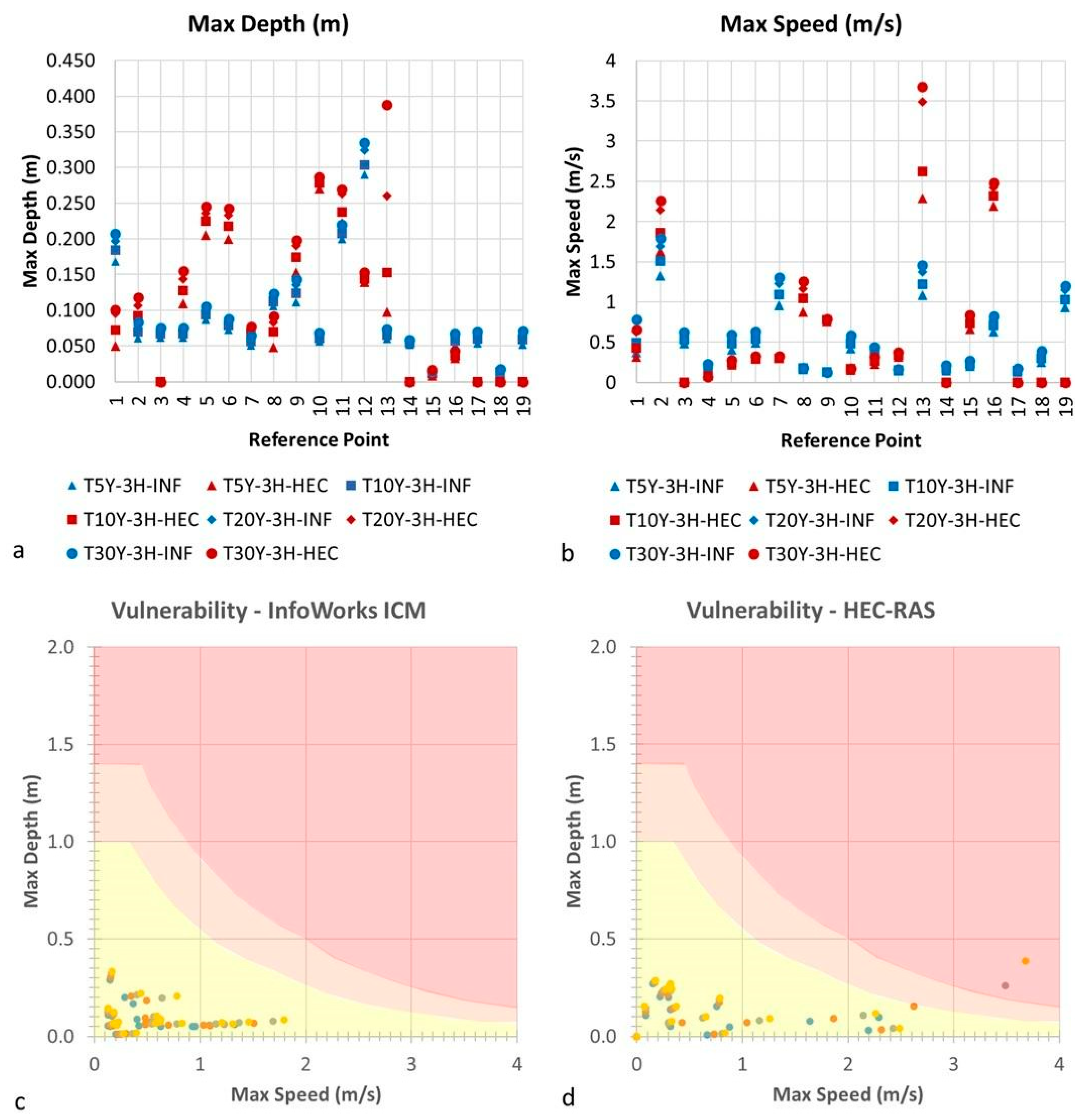
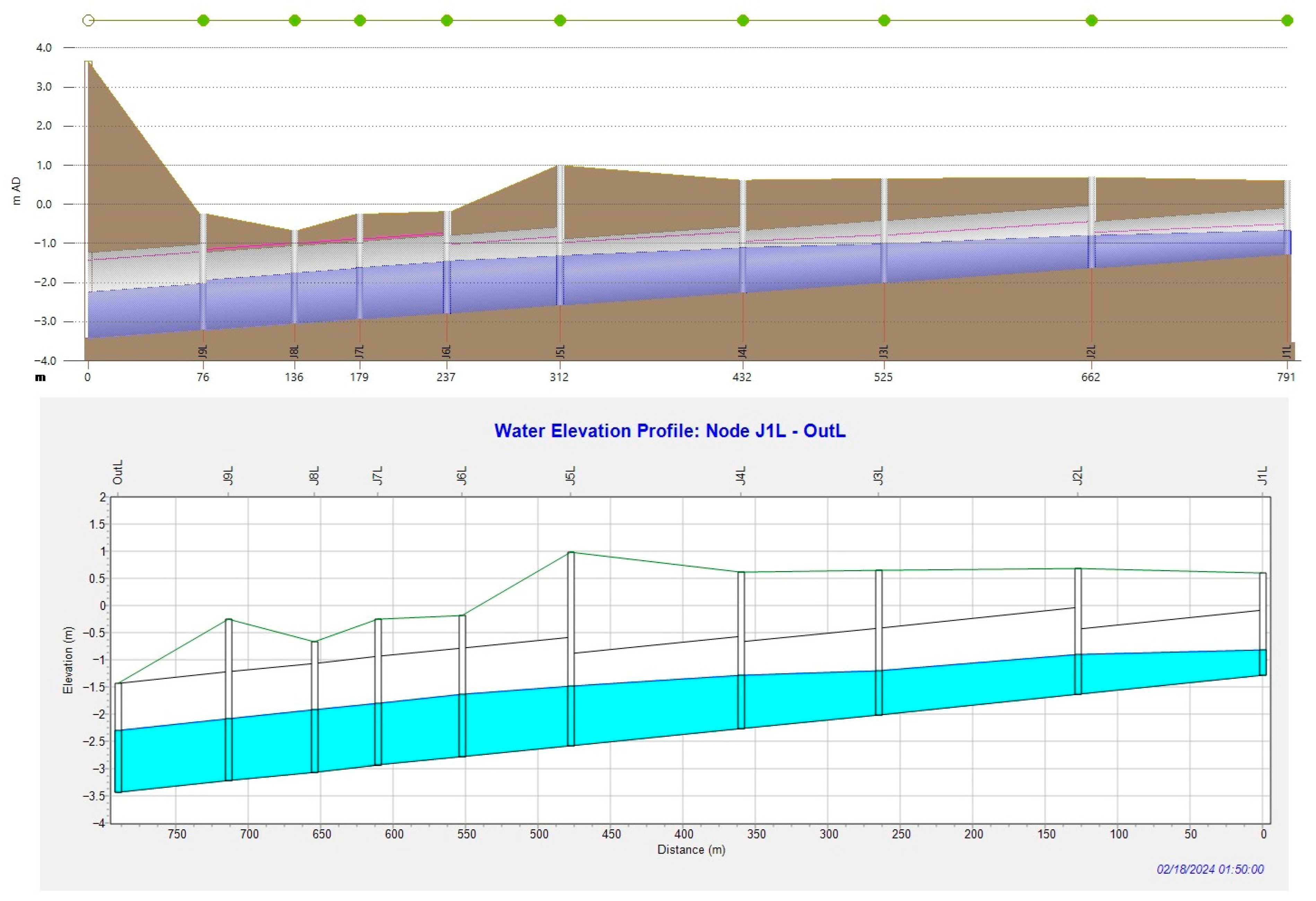
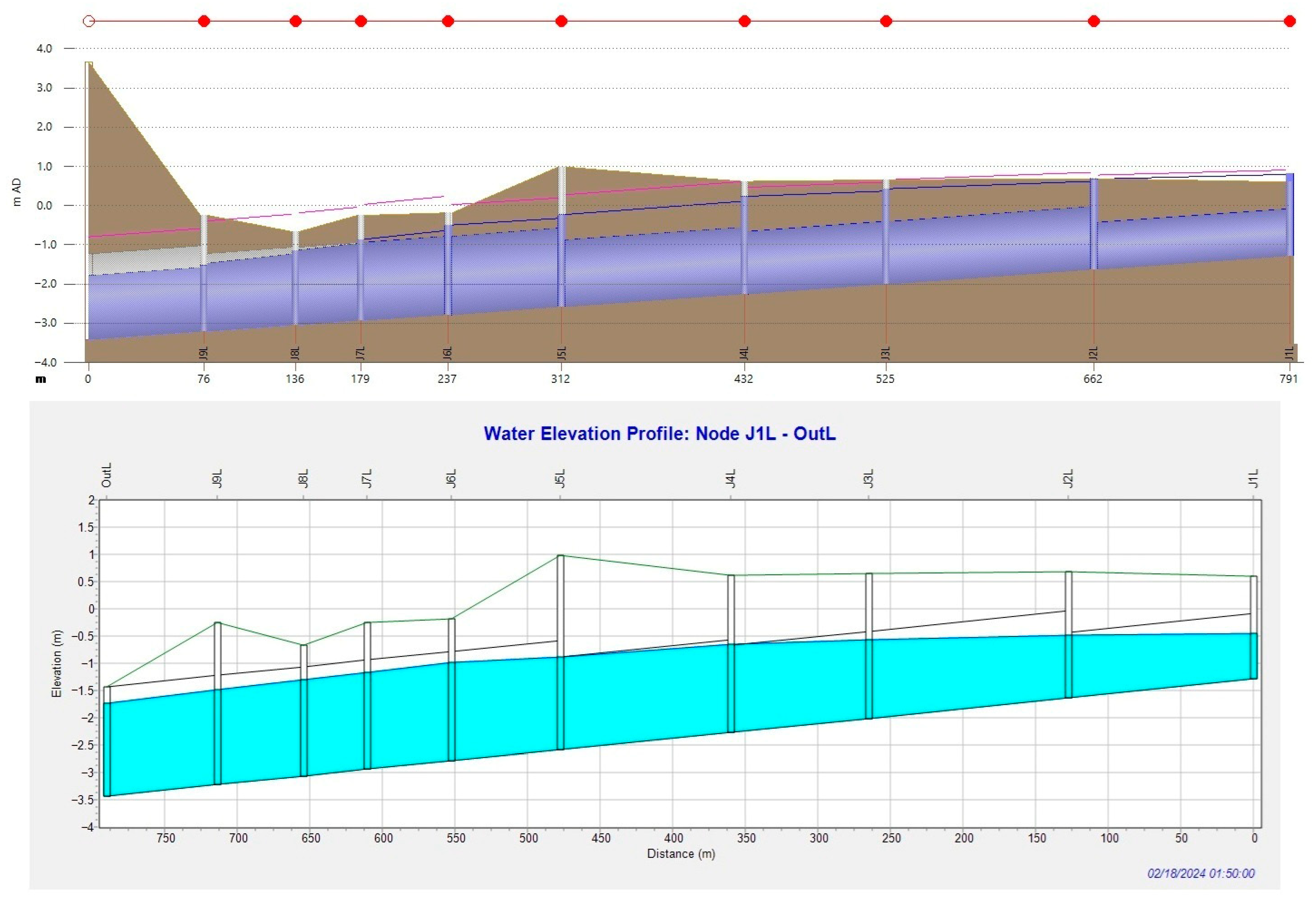
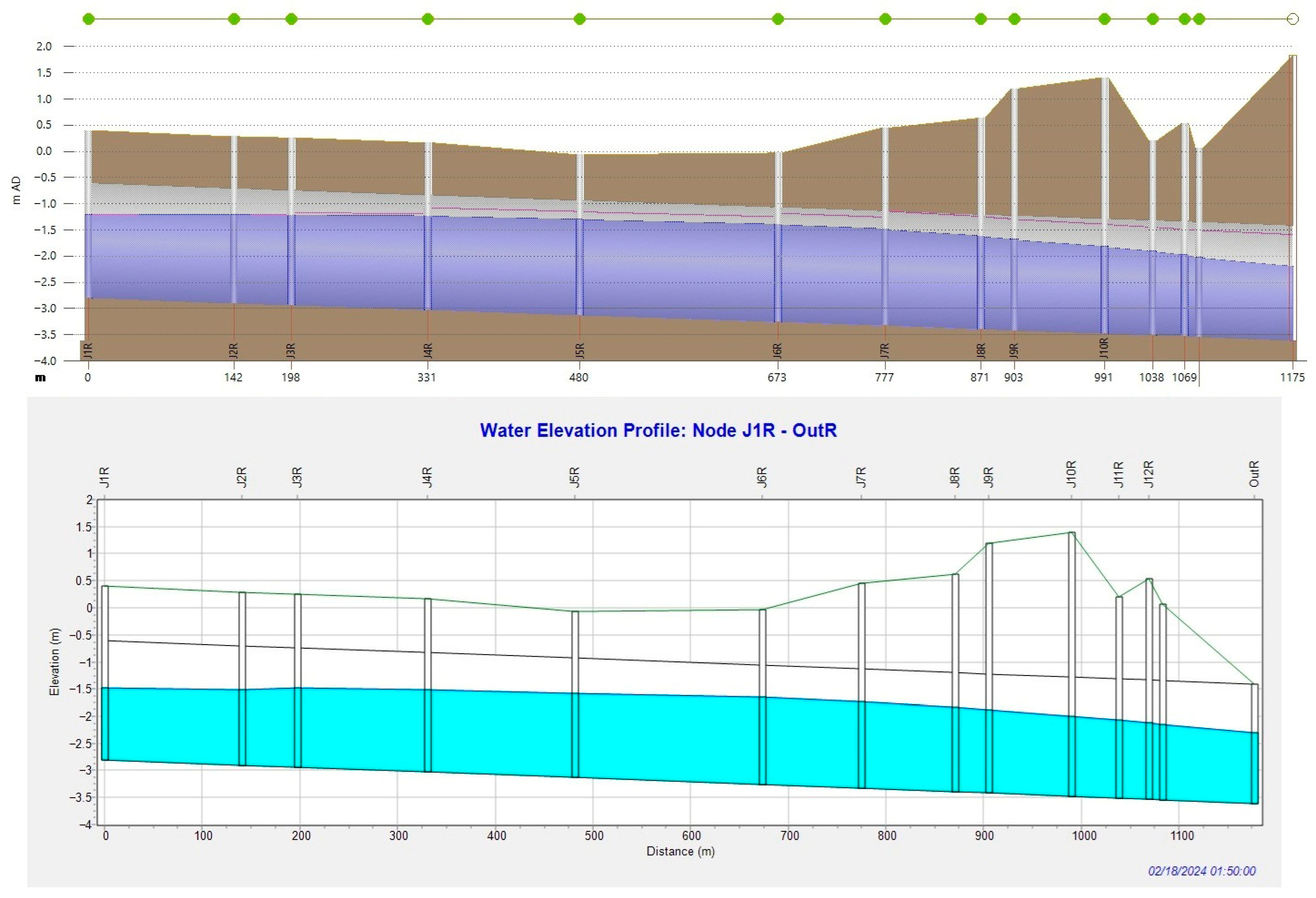
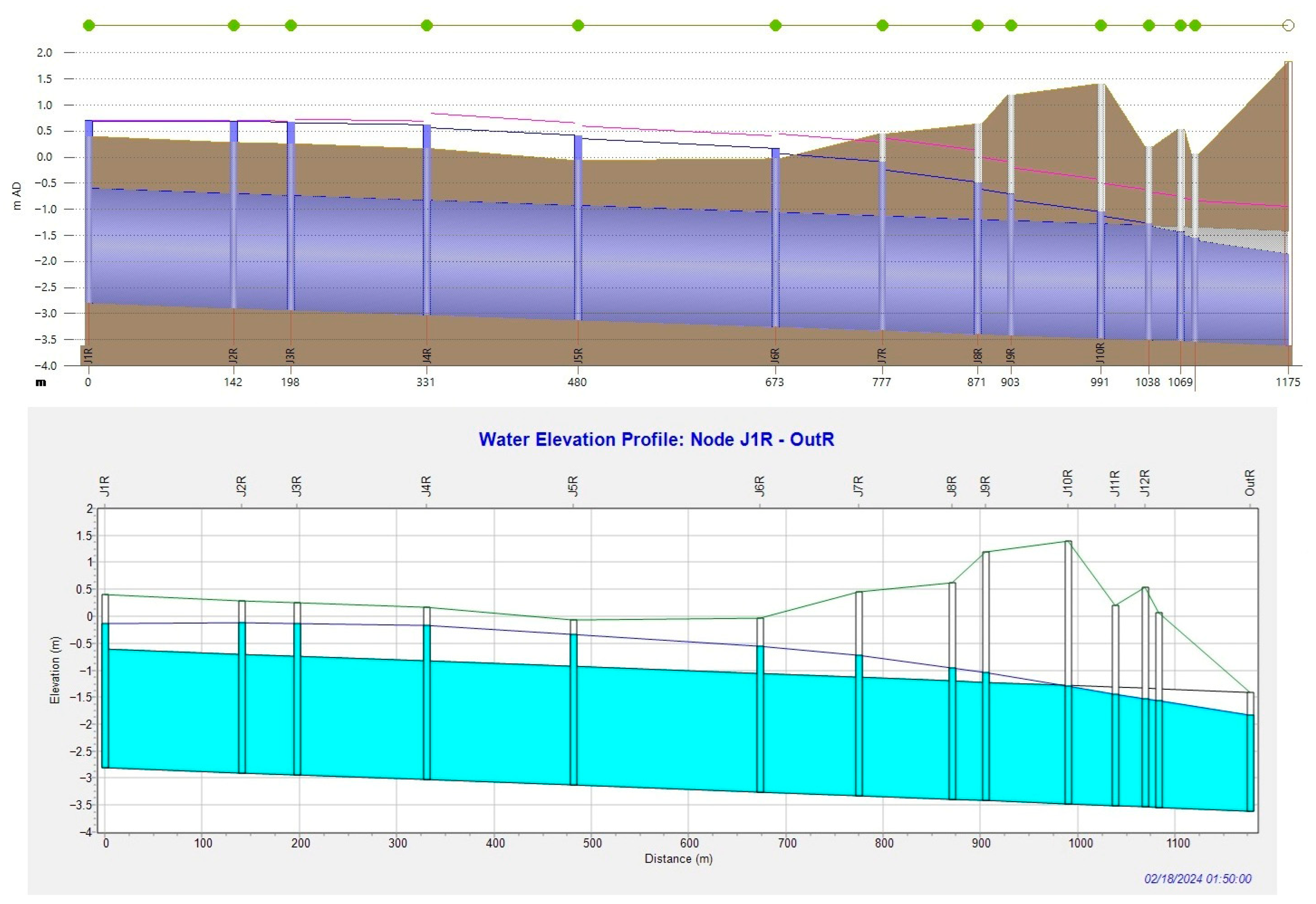
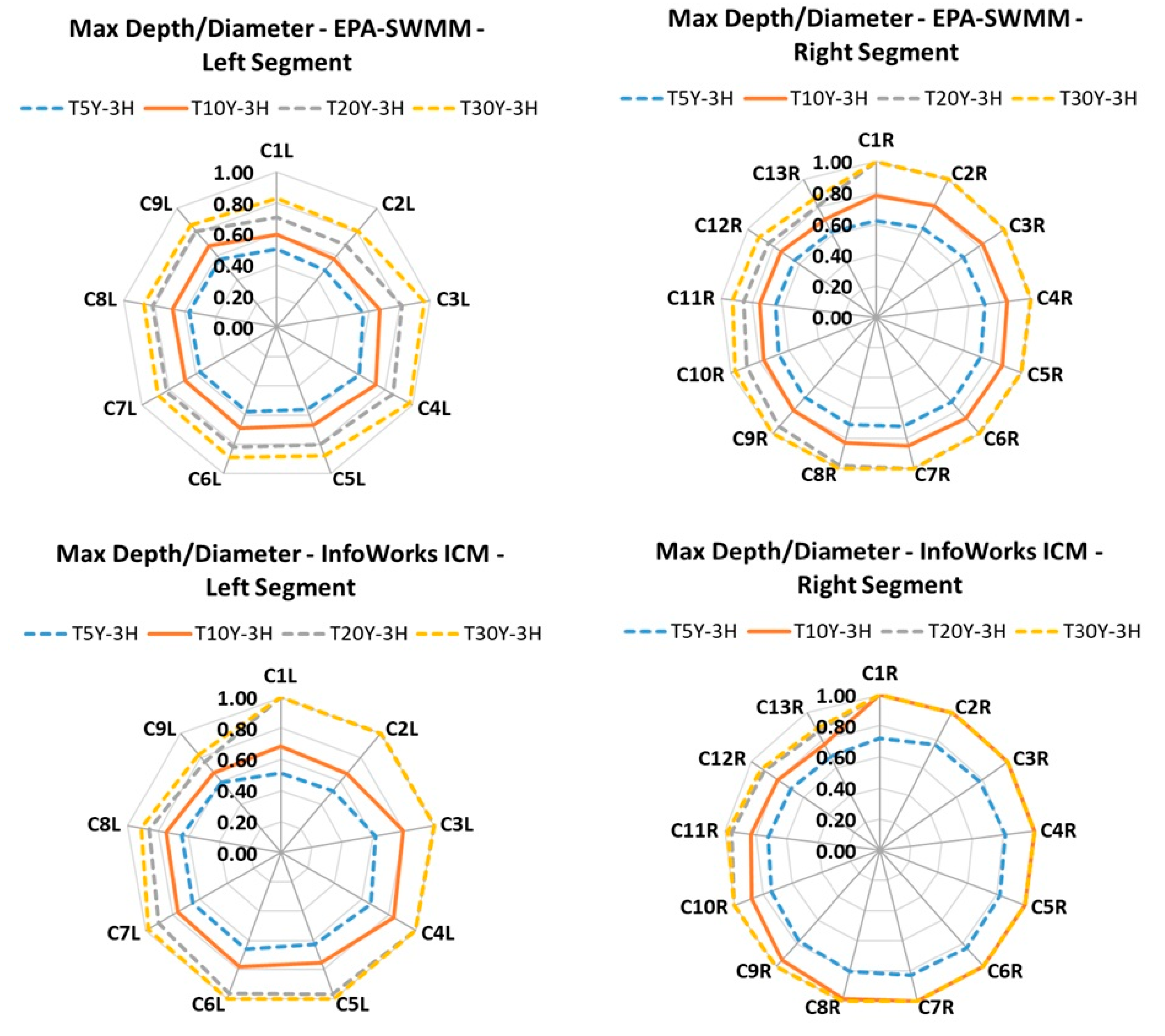
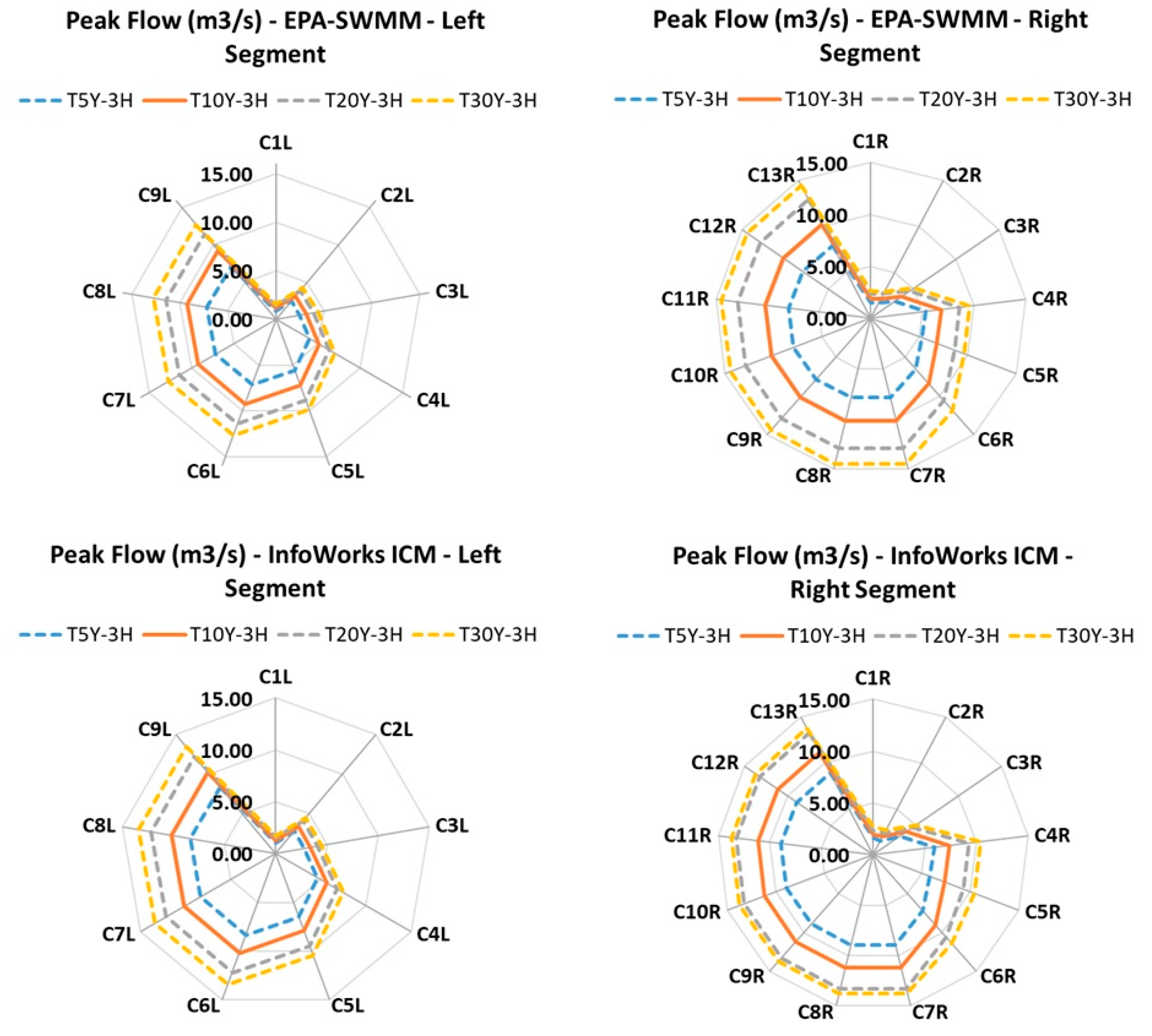
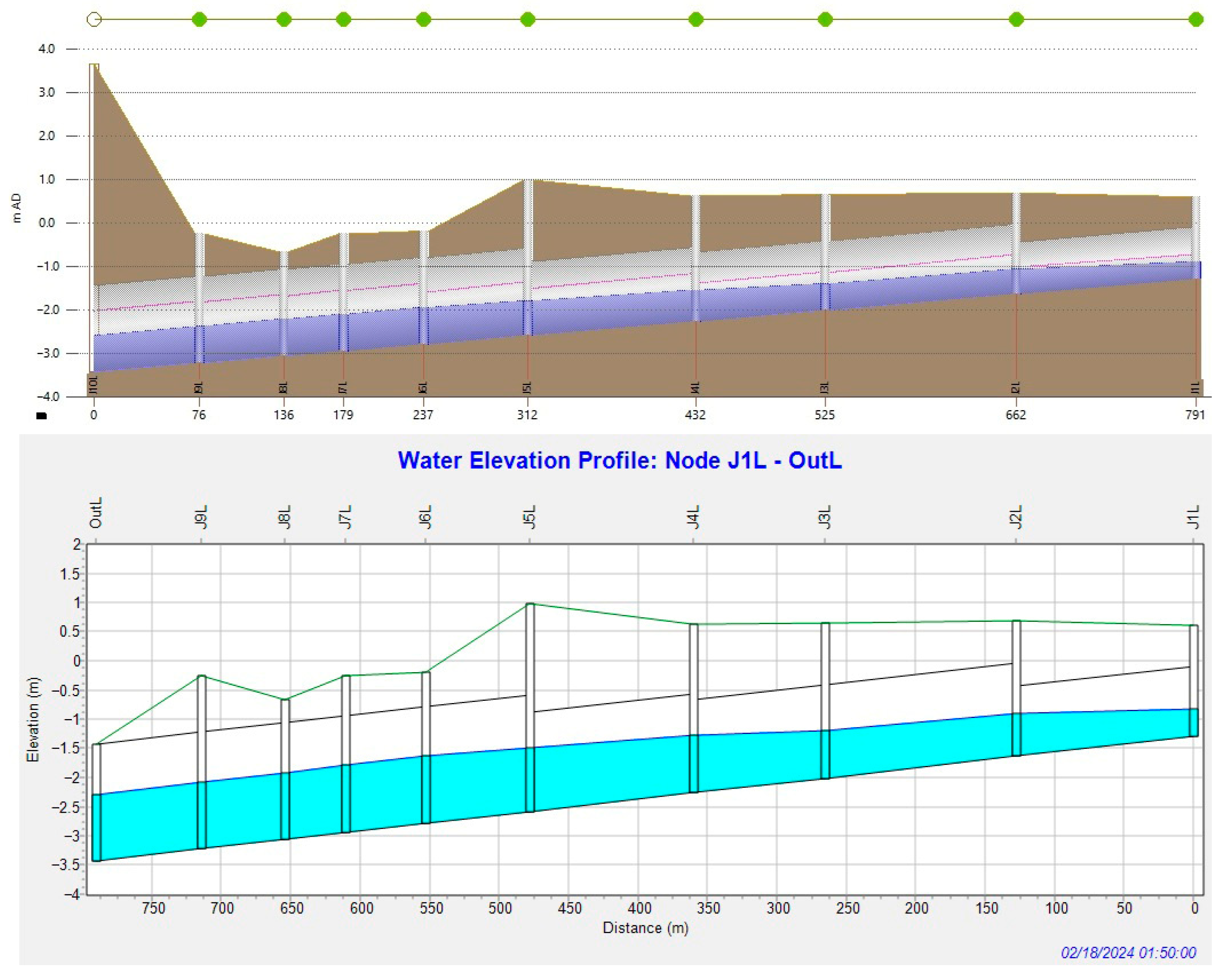
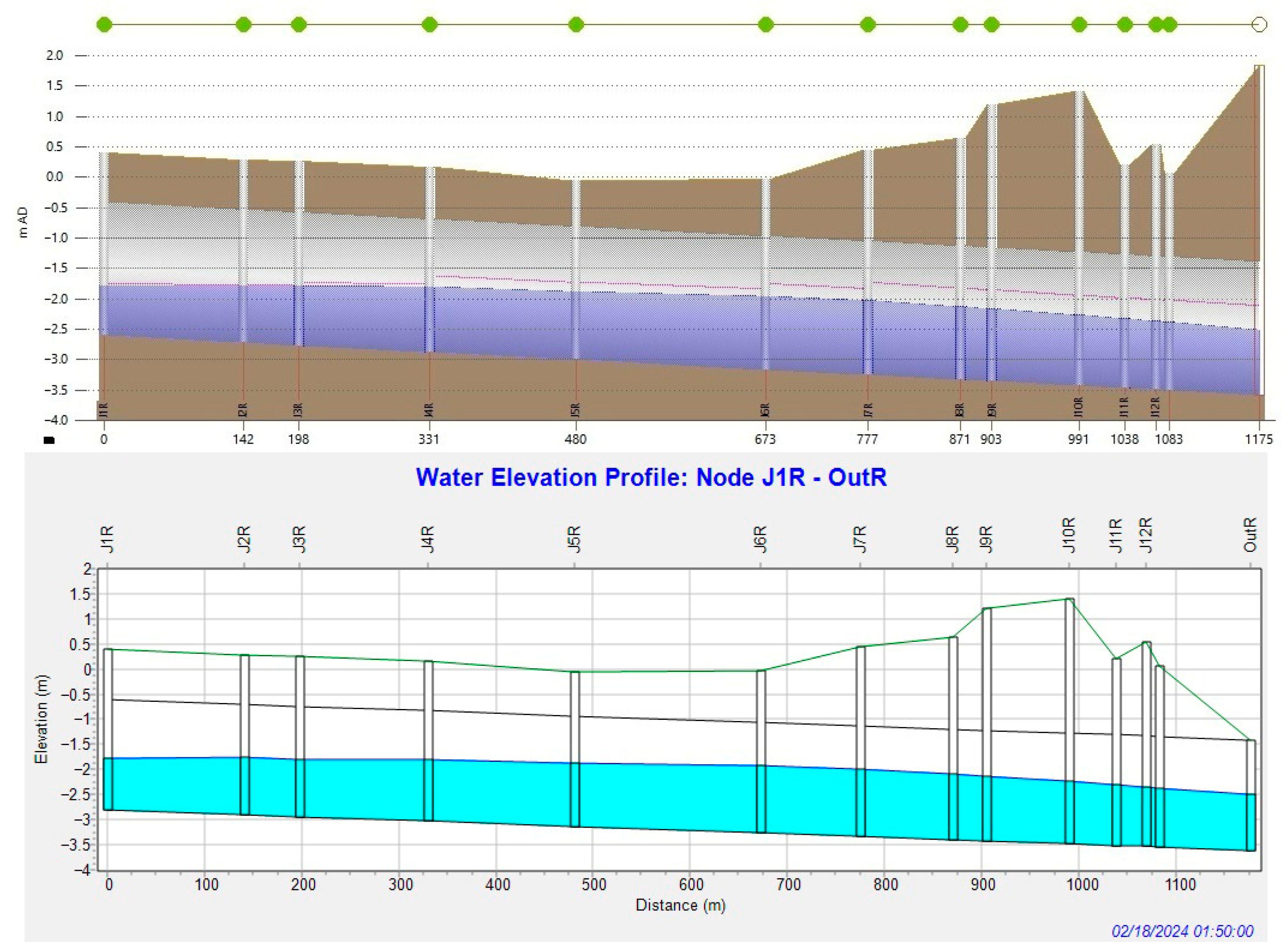
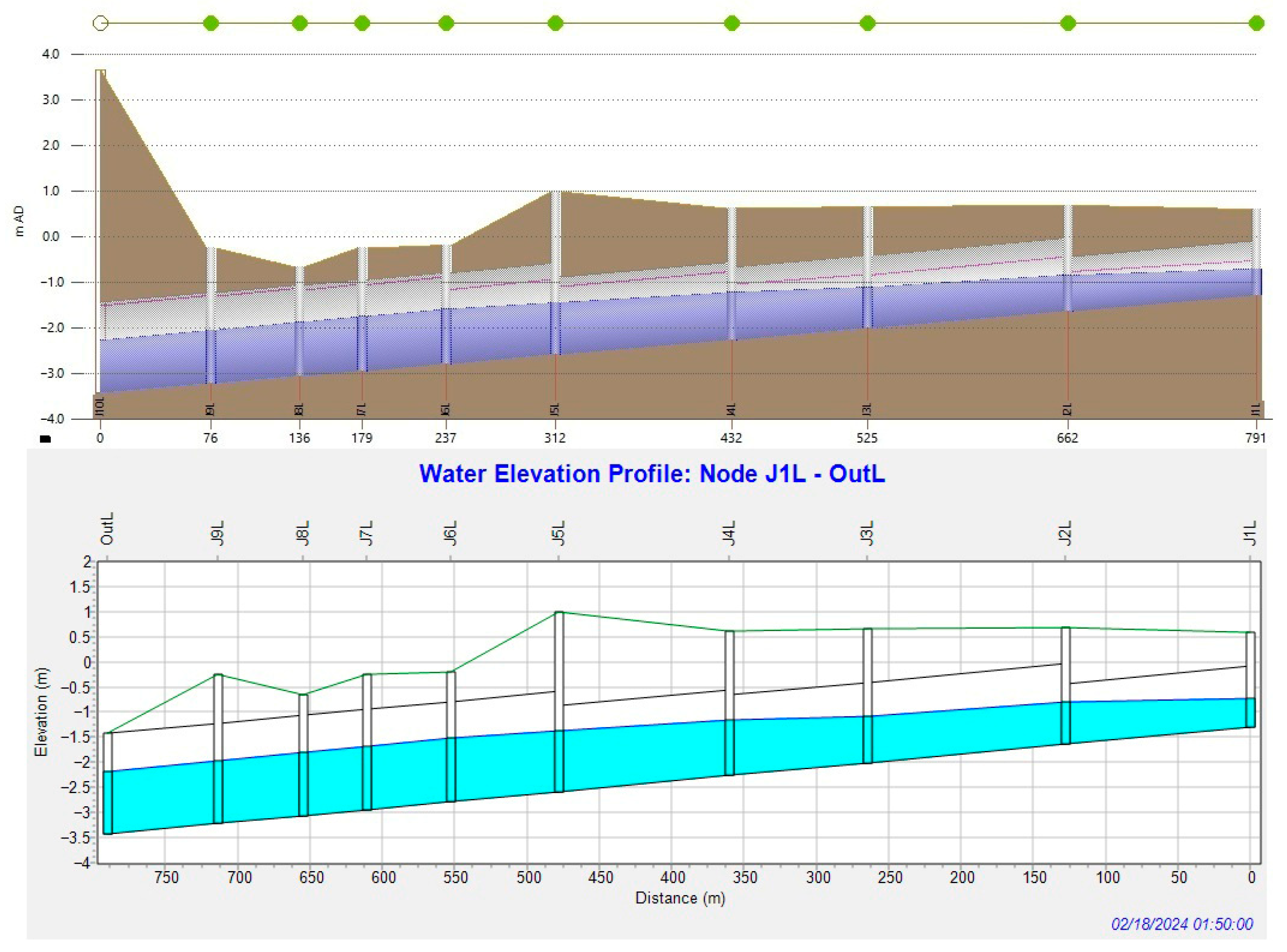
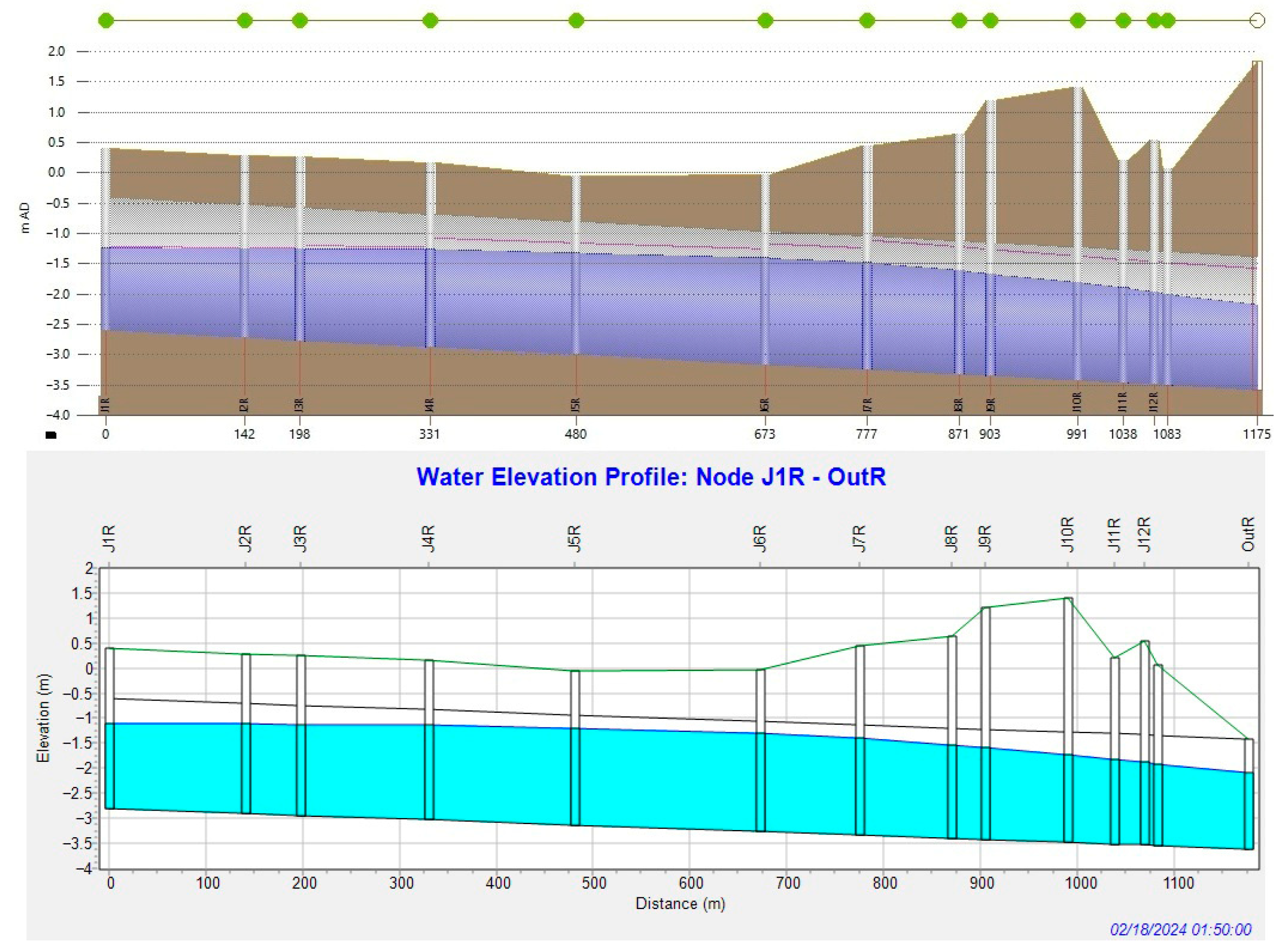
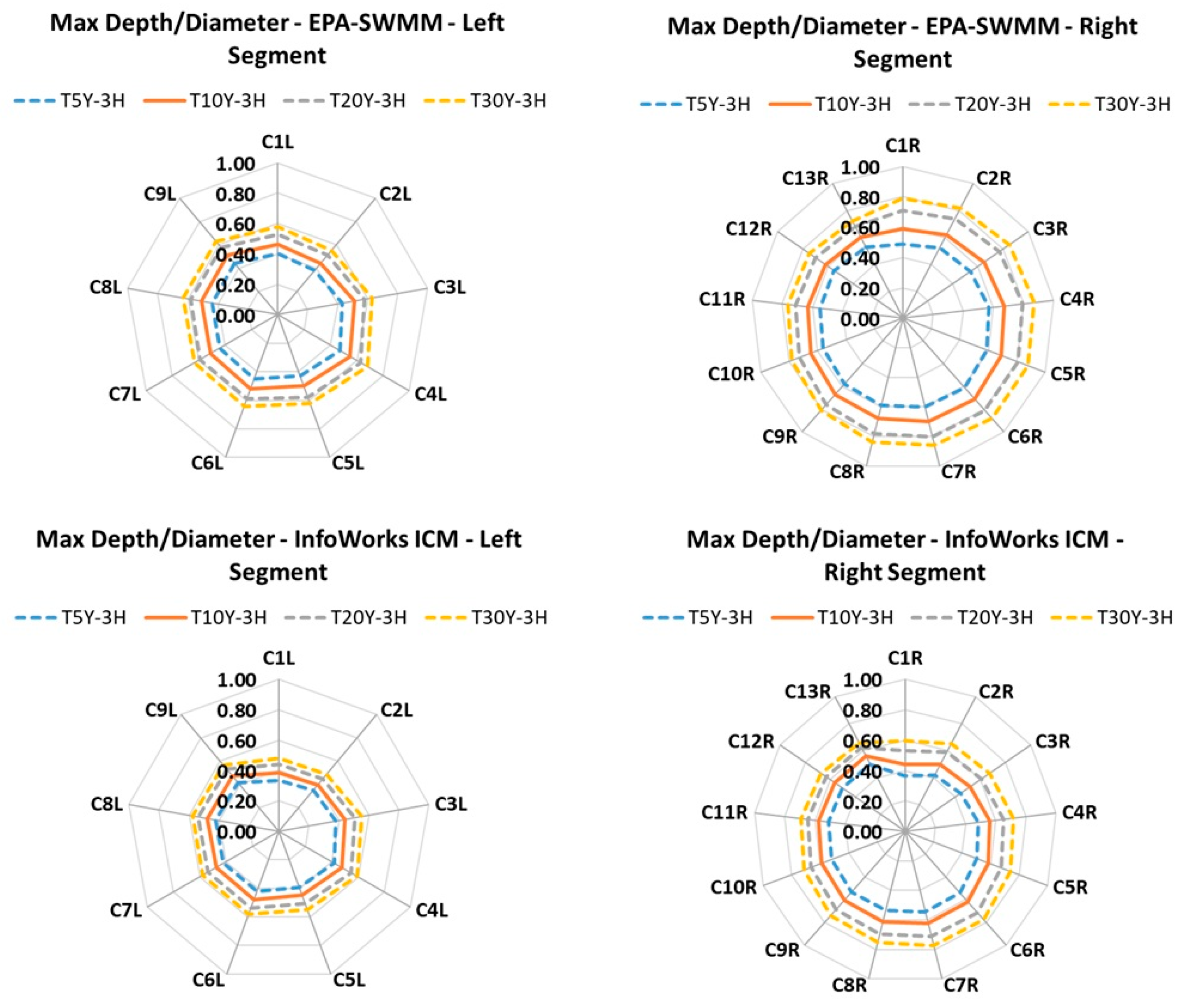
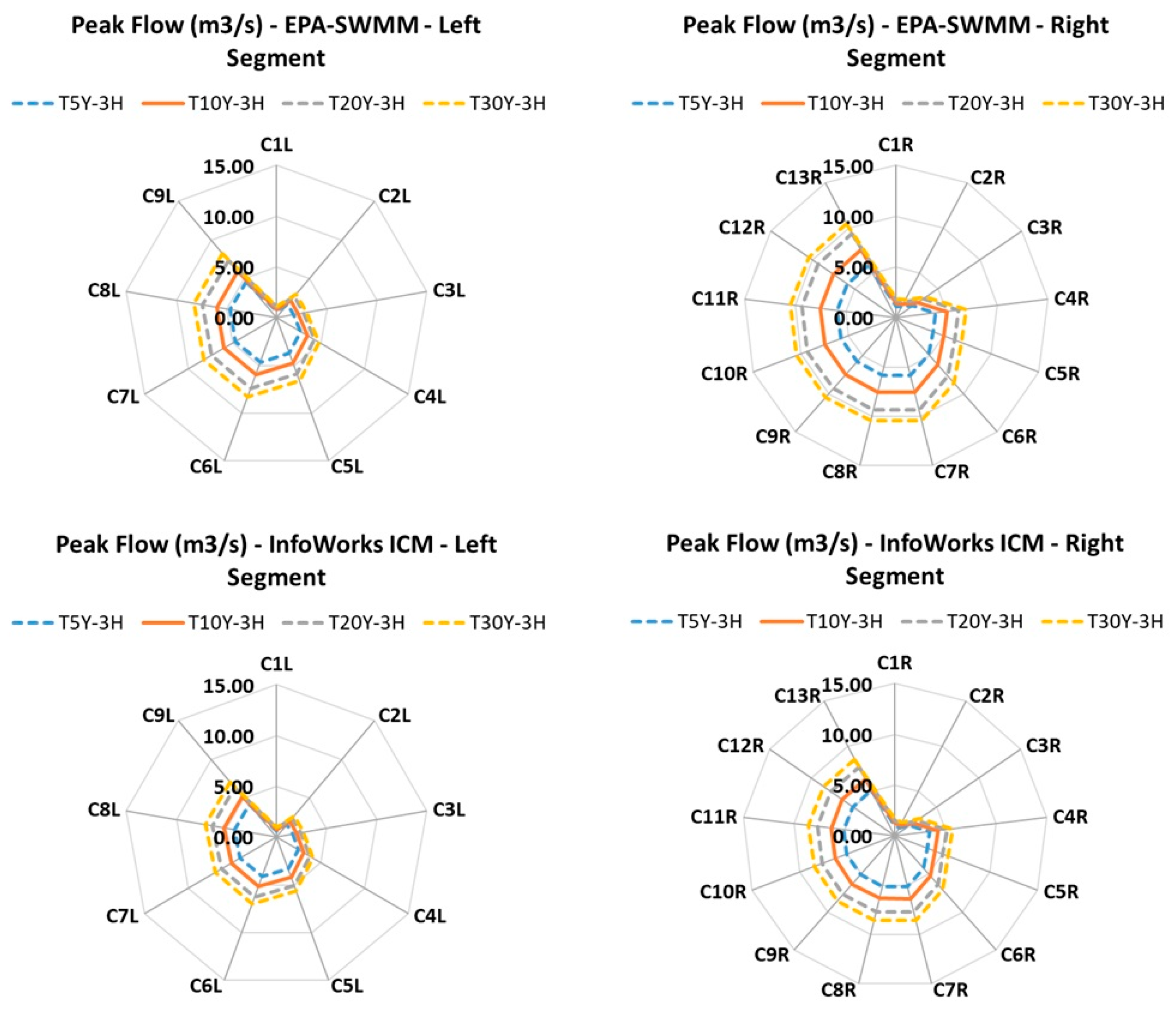
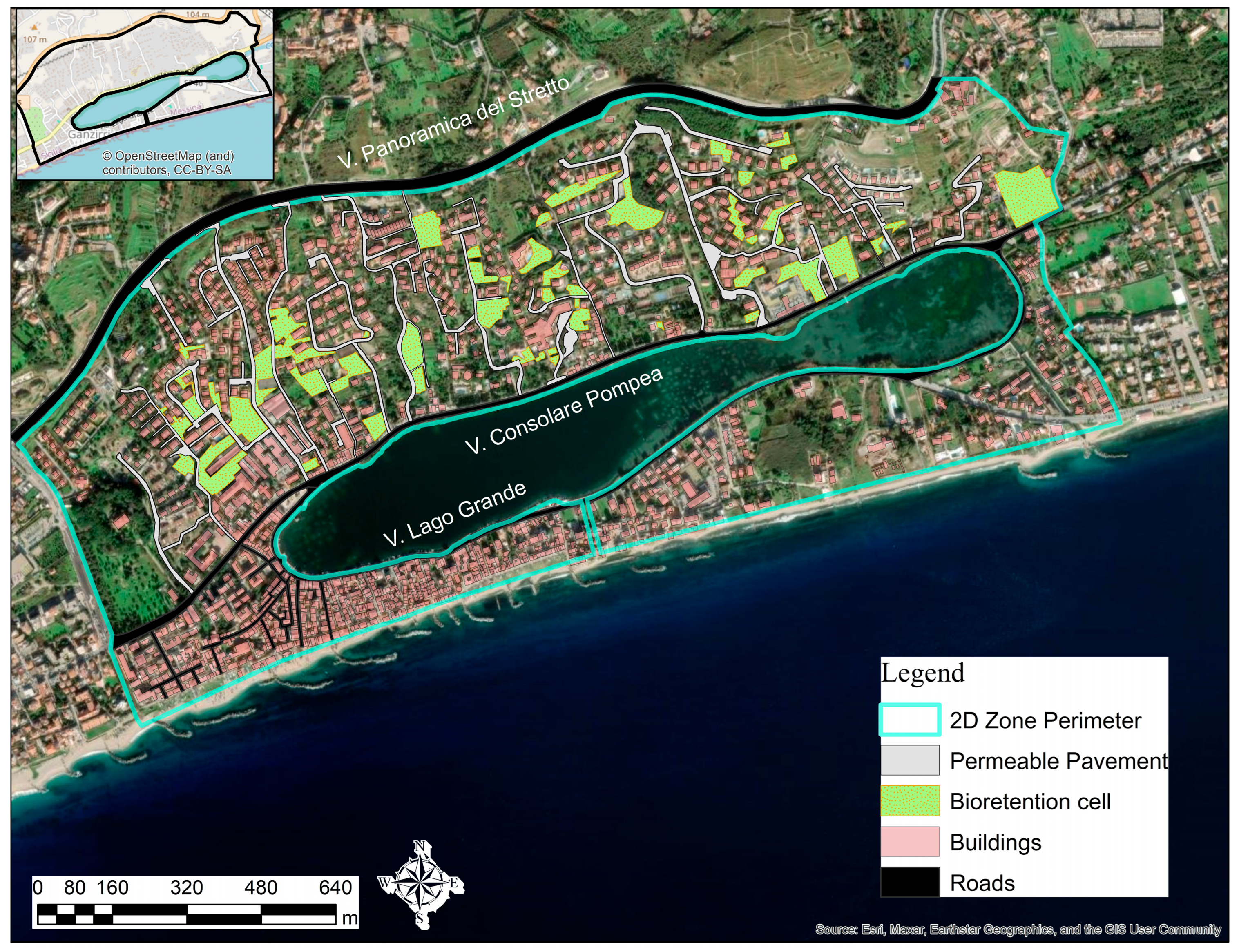
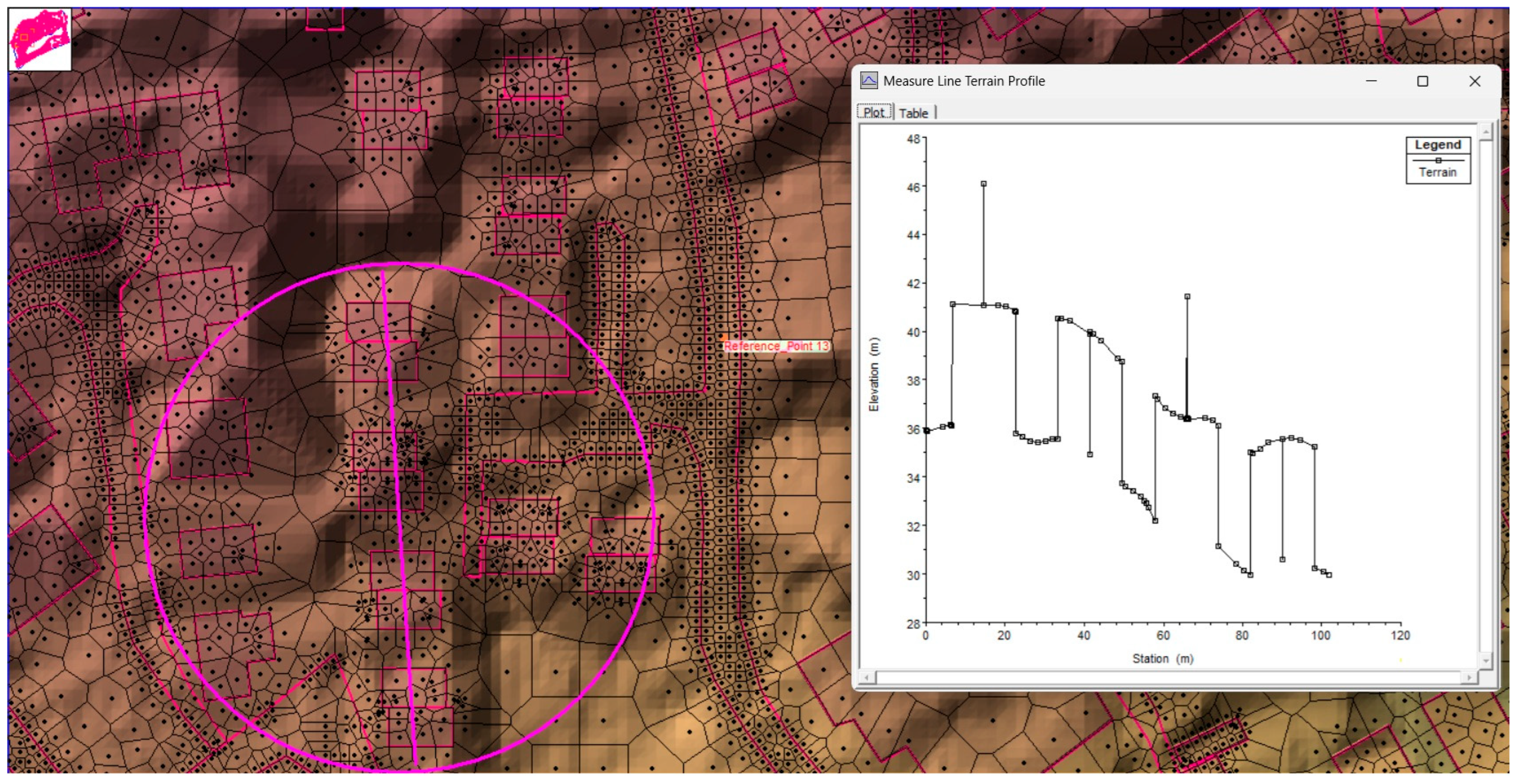
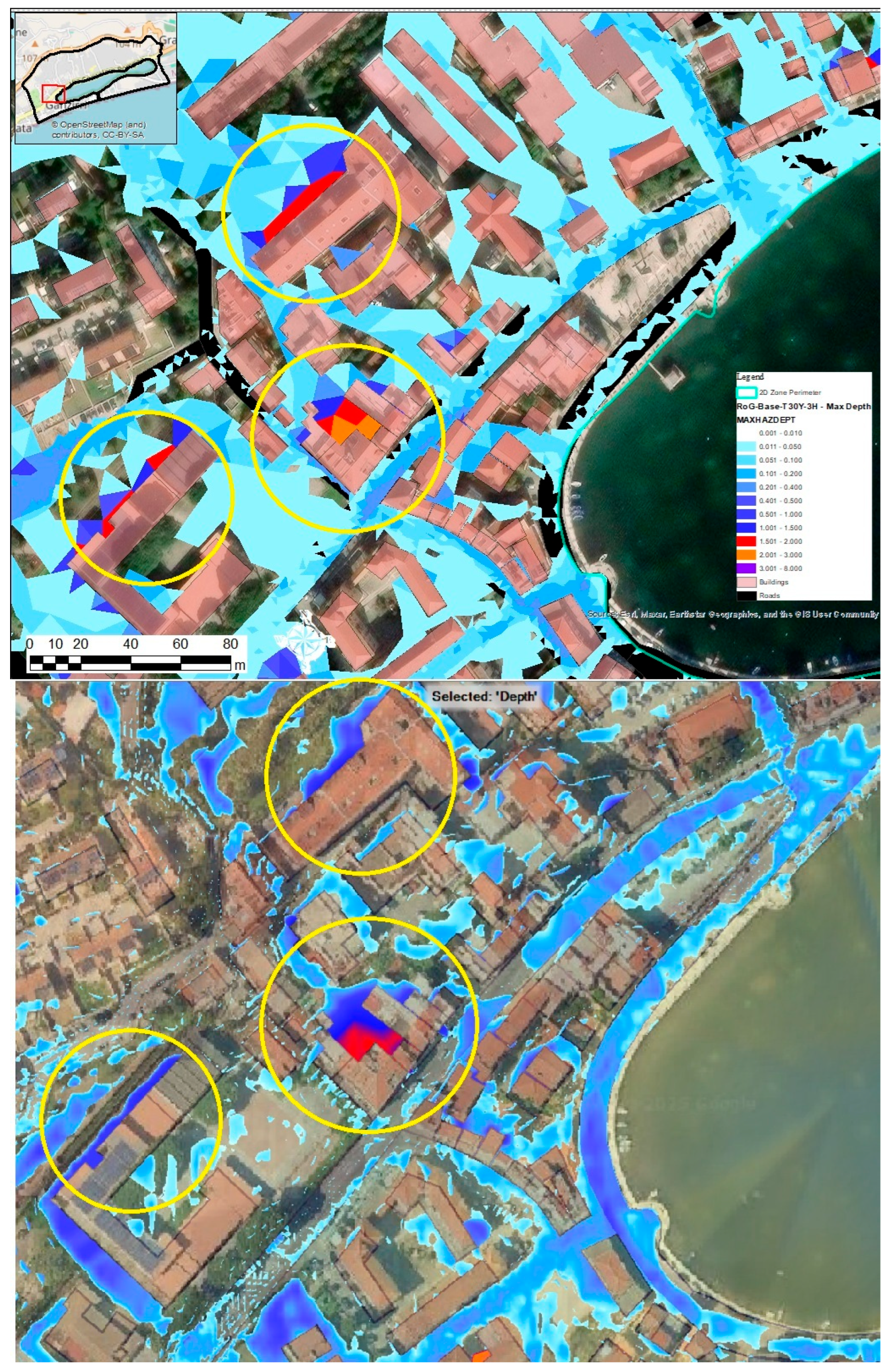
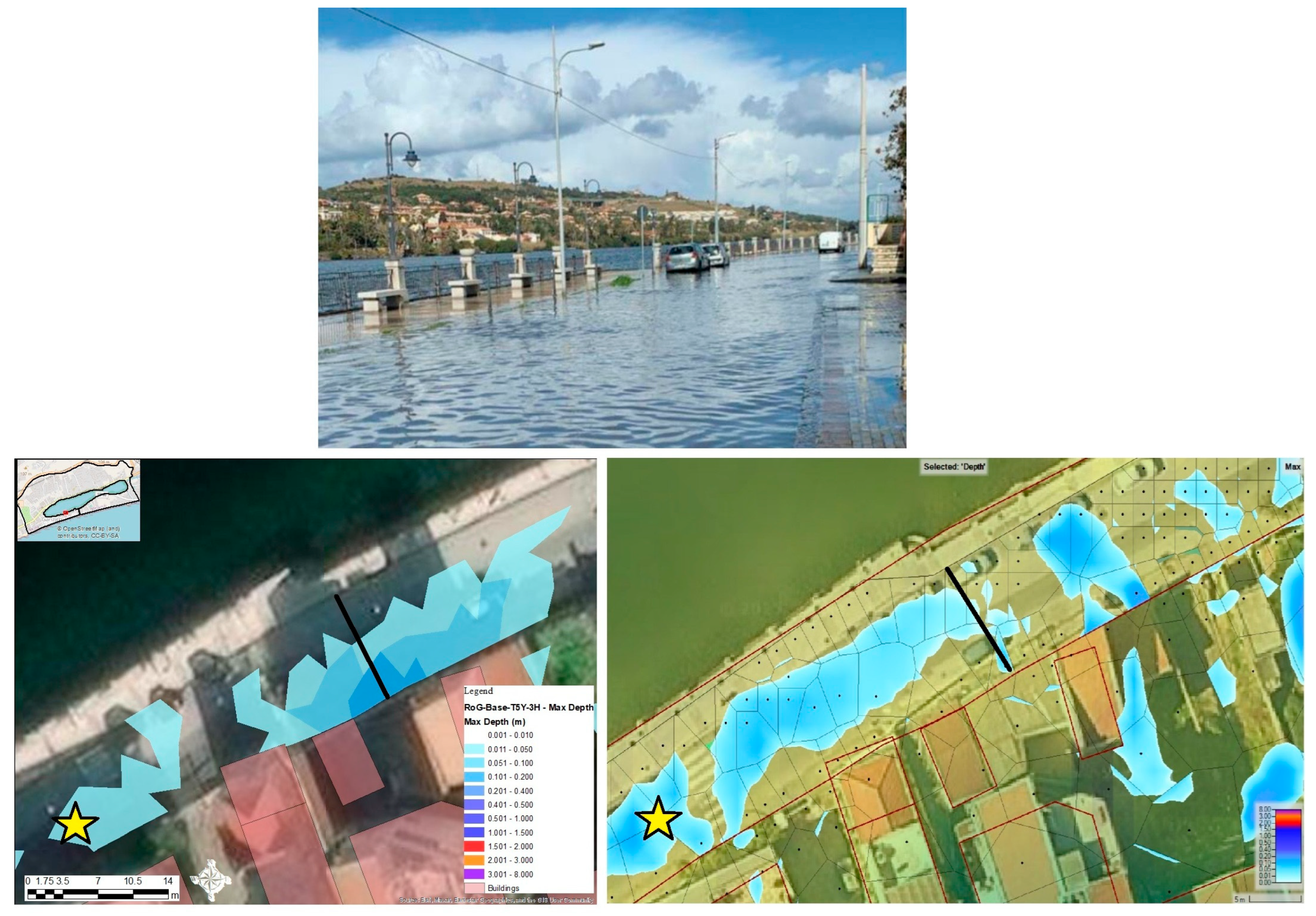
| Characteristics | Laptop 1 | Laptop 2 |
|---|---|---|
| Brand | ASUS | Lenovo |
| GPU | Intel®CoreTM i7 | Intel®CoreTM i7 |
| Processor | 2.40 GHz | 2.59 GHz |
| RAM | 8 GB | 16 GB |
| Used for | HEC-RAS 6.2 Model | InfoWorks ICM 2021.9 Model and EPA-SWMM 5.2 Simulations |
| Comparison Scheme | Software Used | Results—Comparison Methodology |
|---|---|---|
| A | InfoWorks ICM 2021.9 and HEC-RAS 6.2 | Statistics of the 2D Simulation—Numeric Comparison Max Depth and Speed Maps—Visual Comparison Max Depth and Speed from Reference Points—Mean Absolute Error Inundated Area—Numeric Comparison Volume Balance Report—Numerical comparison |
| B | InfoWorks ICM 2021.9 and EPA-SWMM 5.2 | Pipe Profile—Visual Comparison Peak Flow and Relative Height at Peak Flow—Graphical Comparison Runoff Quantity Continuity—Numeric Comparison |
| C | InfoWorks ICM 2021.9 and EPA-SWMM 5.2 | Pipe Profile—Visual Comparison LID/SUDS Objects Proportion or area per sub-catchment Peak Flow and Relative Height at Peak Flow—Graphical Comparison Runoff Quantity Continuity—Numeric Comparison |
| D | InfoWorks ICM 2021.9 and EPA-SWMM 5.2 | Statistics of the 2D Simulation—Numeric Comparison Max Depth and Speed Maps—Visual Comparison Volume Balance Report—Numerical comparison Max Depth and Speed Statistics from Reference Points—Numerical Comparison Inundated Area—Numeric Comparison. |
| Data | Format | Description |
|---|---|---|
| Topography | TIF Files ASC File | One TIF file with RGB information of 0.0167 × 0.0167 m resolution of the road surrounding the Lake Ganzirri (Via Consolare Pompea and Via Lago Grande) with a 100 m-wide band of the surroundings. This information was extracted from a DTM (Digital Terrain Model). One TIF file with elevation information of 0.0167 × 0.0167 m resolution of the road surrounding Lake Ganzirri (Via Consolare Pompea and Via Lago Grande) with a 100 m-wide band of the surroundings. This information was extracted from a DSM (Digital Surface Model). One ASC file of 2 × 2 m resolution of Lake Ganzirri and its surroundings, including the following regions: Casa Bianca, Rione Casalotto, Faro Superiore, Campo Inglese, Contrada Principe, Sant’Agata, Ganzirri, Mortelle, and Torre Faro. |
| Land/Soil Cover | CAD File | CAD file detailing dwellings and buildings, parks, roads, and rustic drainage infrastructure of the case study area. |
| Feature | Type of GIS Features | Description | Use in HEC-RAS 6.2 | Use in InfoWorks ICM 2021.9 |
|---|---|---|---|---|
| Topography. | Raster (ASC File). | 2 × 2 m resolution DEM. | RAS Terrain. | Ground Model Grid. |
| Perimeter of the study area (excluding the lake). | Polygon | The perimeter of the case study area is “donut-shaped” to exclude the lake. | 2D Flow Area. | 2D Zone. |
| Lake Ganzirri Inner Perimeter, East side of the lake, and Coastline 1 | Polylines | The perimeter of Lake Ganzirri and the lines where the runoff is expected to flow out of the 2D zone, according to the topography. | Boundary condition. | N/A |
| Buildings’ footprint (real geometry) 2 | Polygon | Real geometry of the buildings. | Infiltration Layer and Modification Layer in RAS Terrain. | Void Polygons |
| Buildings perimeter | Polylines | Delimitation of each representation of the buildings in the study area. | Breaklines around each building representation. | N/A |
| Roads | Polygons | Representation of the area covered by roads. | Refining regions with a cell size of 2 × 2 m. | Mesh Zones. Roughness Zones. |
| Roads’ perimeter | Polylines | Delimitation of each road polygon. | Breaklines to limit each road. | General line—Category: Break line. |
| Permeable areas | Polygon | Representation of the area covered by permeable green areas and open spaces with grass and bushes. | Land Cover Layer, Infiltration Layer. | Roughness Zone. Infiltration Zone (2D) linked with an Infiltration Surface (2D). |
| Sub-catchments | Polygon | Urban sub-catchments | N/A | Required for the 1D–2D interaction model. |
| Parameter | Value |
|---|---|
| Adjust Time Step Based on Courant | Checked |
| Maximum Courant | 2 |
| Minimum Courant | 0.95 |
| Number of steps below minimum before doubling | 4 |
| Maximum number of doubling base time steps | 4 |
| Maximum number of halving base time steps | 4 |
| Sub-Catchment | Total Area (ha) | Buildings (Roof Area) (ha) | Green Roofs (ha) | Roads (ha) | Permeable Pavement (ha) | Pervious Area (ha) | Bio-Retention Cell (ha) | Residual Areas (ha) |
|---|---|---|---|---|---|---|---|---|
| Basin 1 | 10.43 | 2.07 | - | 1.22 | - | 3.87 | - | 3.28 |
| Basin 2 | 10.33 | 1.78 | - | 1.87 | - | 3.16 | - | 3.53 |
| Basin 3 | 10.37 | 1.58 | - | 1.02 | - | 4.00 | - | 3.78 |
| Basin 4 | 9.71 | 1.25 | - | 1.39 | - | 2.68 | - | 4.38 |
| Basin 5 | 5.92 | 0.71 | - | 0.83 | - | 2.18 | - | 2.20 |
| Basin 6 | 9.01 | 1.05 | - | 0.78 | - | 2.67 | - | 4.52 |
| Basin 7 | 9.10 | 0.78 | - | 1.37 | - | 3.26 | - | 3.69 |
| Basin 8 | 16.14 | 1.45 | - | 2.23 | - | 4.42 | - | 8.04 |
| Basin 9 | 7.84 | 0.71 | - | 0.97 | - | 1.81 | - | 4.36 |
| Basin 10 | 10.08 | 0.93 | - | 0.73 | - | 4.60 | - | 3.82 |
| LID/SUDS Object | Description |
|---|---|
| Green Roofs | All houses implement green roofs in 100% of their roof area. |
| Permeable Pavements | On all roads between Via Panoramica and Via Consolare Pompea (excluding these two). |
| Bioretention cells | On 30% of the available permeable areas of each sub-catchment between Via Panoramica and Via Consolare Pompea. |
| Parameter | Value |
|---|---|
| BIORETENTION CELL | |
| Infiltration Surface (2D) | |
| Infiltration Type | Fixed |
| Fixed Runoff Coefficient | 0.07 |
| Roughness definition | |
| ID | Medium to dense bushes |
| Number of depth bands | 1 |
| Roughness 1 (Manning’s n) | 0.1 |
| PERMEABLE PAVEMENT | |
| Infiltration Surface (2D) | |
| Infiltration Type | Fixed |
| Fixed Runoff Coefficient | 0.7 |
| Roughness definition | |
| ID | Asphalt |
| Number of depth bands | 1 |
| Roughness 1 (Manning’s n) | 0.016 |
| InfoWorks ICM 2021.9 | HEC-RAS 6.2 | InfoWorks ICM 2021.9 | HEC-RAS 6.2 | |
|---|---|---|---|---|
| Computation Points | 70,892 | 64,787 | 70,892 | 64,787 |
| Average Simulation time | 01h37m | 04h02m | 01h37m | 04h02m |
| Max Depth (m) | Max Depth (m) | Max Speed (m/s) | Max Speed (m/s) | |
| T5Y-3H | ||||
| Mean | 0.021 | 0.926 (0.116) | 0.184 | 0.108 |
| Std. Dev. | 0.058 | 1.259 (0.190) | 0.262 | 0.163 |
| Min | 0.001 | 0.001 (0.001) | 0 | 0 |
| Max | 2.083 | 7.337 (3.541) | 2.484 | 2.73 |
| T10Y-3H | ||||
| Mean | 0.023 | 0.921 (0.116) | 0.209 | 0.117 |
| Std. Dev. | 0.062 | 1.252 (0.190) | 0.292 | 0.176 |
| Min | 0.001 | 0.001 (0.001) | 0 | 0 |
| Max | 2.28 | 7.337 (3.541) | 2.695 | 2.946 |
| T20Y-3H | ||||
| Mean | 0.025 | 0.915 (0.116) | 0.234 | 0.126 |
| Std. Dev. | 0.065 | 1.249 (0.190) | 0.322 | 0.189 |
| Min | 0.001 | 0.001 (0.001) | 0 | 0 |
| Max | 2.321 | 7.337 (3.541) | 2.9 | 3.147 |
| T30Y-3H | ||||
| Mean | 0.027 | 0.912 (0.116) | 0.249 | 0.131 |
| Std. Dev. | 0.067 | 1.247 (0.190) | 0.339 | 0.196 |
| Min | 0.001 | 0.001 (0.001) | 0 | 0 |
| Max | 2.394 | 7.337 (3.541) | 3.127 | 3.263 |
| Rainfall Event | MAE Depth (m) | MAE Speed (m/s) |
|---|---|---|
| T5Y-3H | 0.064 | 0.446 |
| T10Y-3H | 0.071 | 0.506 |
| T20Y-3H | 0.080 | 0.589 |
| T30Y-3H | 0.089 | 0.625 |
| T5Y-3H | T10Y-3H | T20Y-3H | T30Y-3H | |
|---|---|---|---|---|
| Initial LID Storage (mm) | 24.357 (-) | 24.357 (-) | 24.357 (-) | 24.357 (-) |
| Total Precipitation (mm) | 50.0 (50.0) | 60.9 (60.9) | 72.6 (72.6) | 80.0 (80.0) |
| Evaporation Loss (mm) | 0.0 (0.0) | 0.0 (0.0) | 0.0 (0.0) | 0.0 (0.0) |
| Infiltration Loss (mm) | 16.187 (17.519) | 17.848 (18.649) | 19.406 (19.358) | 20.331 (20.012) |
| Surface Runoff (mm) | 19.973 (28.641) | 26.826 (38.477) | 34.111 (48.941) | 38.981 (55.928) |
| LID Drainage (mm) | - (-) | 0.477 (-) | 1.635 (-) | 2.367 (-) |
| Final Storage (mm) | 38.859 (4.801) | 40.821 (4.805) | 42.315 (4.861) | 43.248 (4.877) |
| Max Depth (m) | Max Speed (m/s) | |
|---|---|---|
| Computation Points | 70,892 | 70,892 |
| Average Simulation time | 01h37m | 01h37m |
| T5Y-3H | ||
| Mean | 0.019 (0.021) | 0.173 (0.184) |
| Std. Dev. | 0.056 (0.058) | 0.250 (0.262) |
| Min | 0.001 (0.001) | 0 (0) |
| Max | 2.077 (2.083) | 2.390 (2.484) |
| T10Y-3H | ||
| Mean | 0.022 (0.023) | 0.197 (0.209) |
| Std. Dev. | 0.061 (0.062) | 0.279 (0.292) |
| Min | 0.001 (0.001) | 0 (0) |
| Max | 2.170 (2.280) | 2.593 (2.695) |
| T20Y-3H | ||
| Mean | 0.024 (0.025) | 0.221 (0.234) |
| Std. Dev. | 0.064 (0.065) | 0.307 (0.322) |
| Min | 0.001 (0.001) | 0 (0) |
| Max | 2.315 (2.321) | 2.791 (2.900) |
| T30Y-3H | ||
| Mean | 0.026 (0.027) | 0.235 (0.249) |
| Std. Dev. | 0.066 (0.067) | 0.324 (0.339) |
| Min | 0.001 (0.001) | 0 (0) |
| Max | 2.392 (2.394) | 2.979 (3.127) |
| T5Y-3H | T10Y-3H | T20Y-3H | T30Y-3H | |
|---|---|---|---|---|
| Rainfall Inflow (m3) | 62,759 (62,759) | 80,609 (80,609) | 85,070 (85,070) | 98,339 (98,339) |
| Infiltration (m3) | 10,782 (6572) | 13,050 (7858) | 15,416 (9679) | 16,622 (10,504) |
| By Permeable Pavement | 1191 (0) | 1424 (0) | 1755 (0) | 1904 (0) |
| By Semipermeable Areas | 5187 (6572) | 6202 (7858) | 7639 (9679) | 8291 (10,504) |
| Within intervention area | 3162 | 3781 | 4657 | 5054 |
| Outside intervention area | 2025 | 2421 | 2982 | 3237 |
| By Bioretention Cells | 4404 (0) | 5424 (0) | 6022 (0) | 6427 (0) |
| Normal boundaries (m3) | 38,389 (42,315) | 48,372 (53,295) | 59,444 (65,370) | 66,463 (72,985) |
| Infiltration Within Intervention Area (m3) | 8758 | 10,629 | 12,434 | 13,386 |
| InfoWorks ICM 2021.9 | InfoWorks ICM 2021.9 | |
|---|---|---|
| Reference Points | 19 | 19 |
| Max Depth (m) | Max Speed (m/s) | |
| T5Y-3H | ||
| Min | 0.009 (0.011) | 0.072 (0.129) |
| Mean | 0.081 (0.085) | 0.419 (0.458) |
| Max | 0.285 (0.290) | 1.202 (1.327) |
| T10Y-3H | ||
| Min | 0.009 (0.012) | 0.082 (0.127) |
| Mean | 0.087 (0.092) | 0.479 (0.523) |
| Max | 0.292 (0.304) | 1.385 (1.510) |
| T20Y-3H | ||
| Min | 0.011 (0.013) | 0.093 (0.128) |
| Mean | 0.094 (0.099) | 0.541 (0.590) |
| Max | 0.311 (0.324) | 1.554 (1.689) |
| T30Y-3H | ||
| Min | 0.011 (0.014) | 0.099 (0.129) |
| Mean | 0.098 (0.103) | 0.579 (0.631) |
| Max | 0.320 (0.334) | 1.651 (1.796) |
| Rainfall Event | Scenario S0 (No LID/SUDS) | Scenario S3 (with LID/SUDS) |
|---|---|---|
| T5Y-3H | 43.51 | 41.87 |
| T10Y-3H | 48.22 | 46.68 |
| T20Y-3H | 52.71 | 50.97 |
| T30Y-3H | 55.32 | 53.48 |
Disclaimer/Publisher’s Note: The statements, opinions and data contained in all publications are solely those of the individual author(s) and contributor(s) and not of MDPI and/or the editor(s). MDPI and/or the editor(s) disclaim responsibility for any injury to people or property resulting from any ideas, methods, instructions or products referred to in the content. |
© 2025 by the authors. Licensee MDPI, Basel, Switzerland. This article is an open access article distributed under the terms and conditions of the Creative Commons Attribution (CC BY) license (https://creativecommons.org/licenses/by/4.0/).
Share and Cite
Serrano Chano, J.J.; Brigandi, G.; Aronica, G.T. Comparison of Pluvial Flooding Modeling Software Applied in Highly Urbanized Settlements Using the Case of Lake Ganzirri. Water 2025, 17, 2978. https://doi.org/10.3390/w17202978
Serrano Chano JJ, Brigandi G, Aronica GT. Comparison of Pluvial Flooding Modeling Software Applied in Highly Urbanized Settlements Using the Case of Lake Ganzirri. Water. 2025; 17(20):2978. https://doi.org/10.3390/w17202978
Chicago/Turabian StyleSerrano Chano, José Javier, Giuseppina Brigandi, and Giuseppe Tito Aronica. 2025. "Comparison of Pluvial Flooding Modeling Software Applied in Highly Urbanized Settlements Using the Case of Lake Ganzirri" Water 17, no. 20: 2978. https://doi.org/10.3390/w17202978
APA StyleSerrano Chano, J. J., Brigandi, G., & Aronica, G. T. (2025). Comparison of Pluvial Flooding Modeling Software Applied in Highly Urbanized Settlements Using the Case of Lake Ganzirri. Water, 17(20), 2978. https://doi.org/10.3390/w17202978








